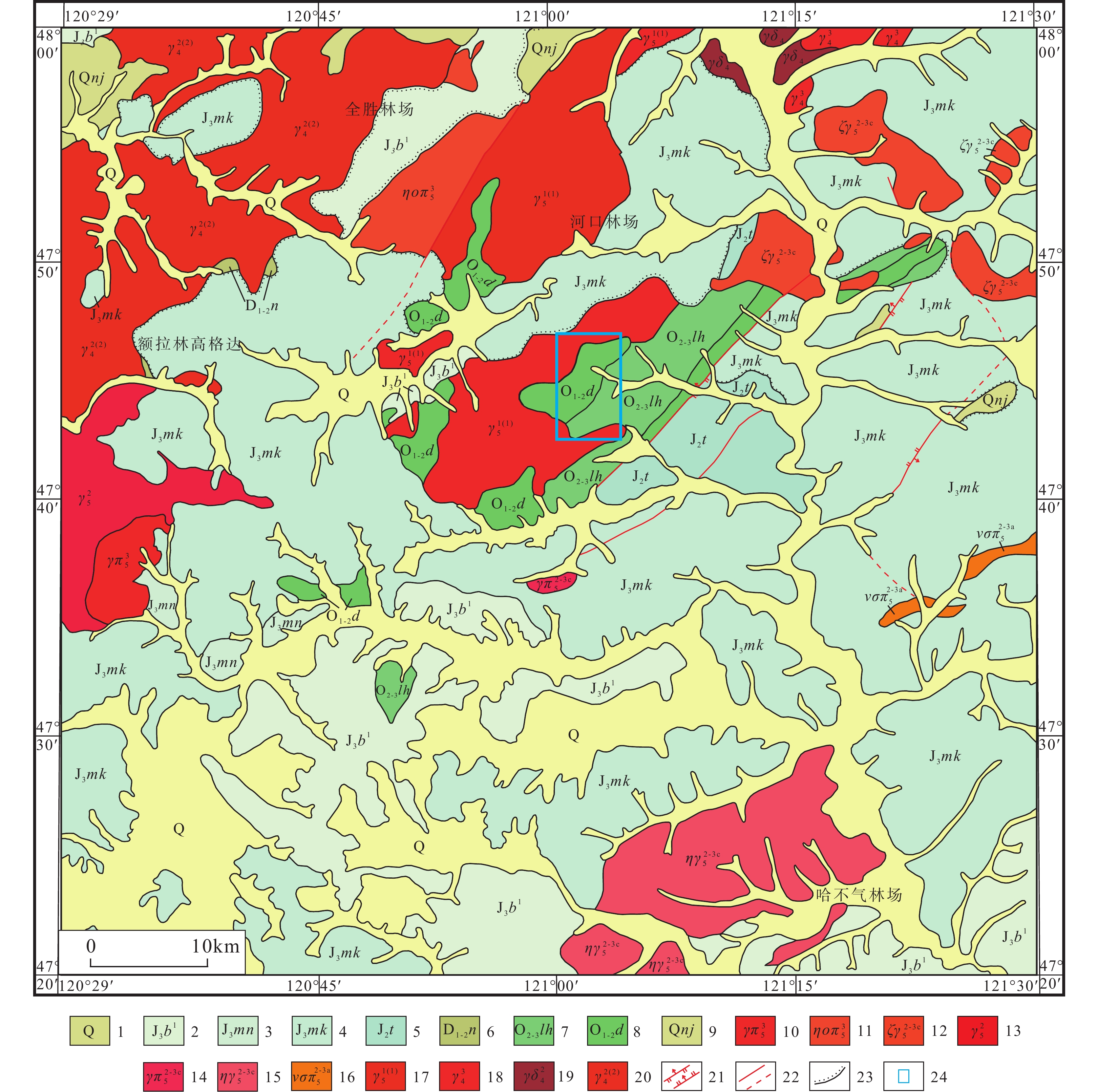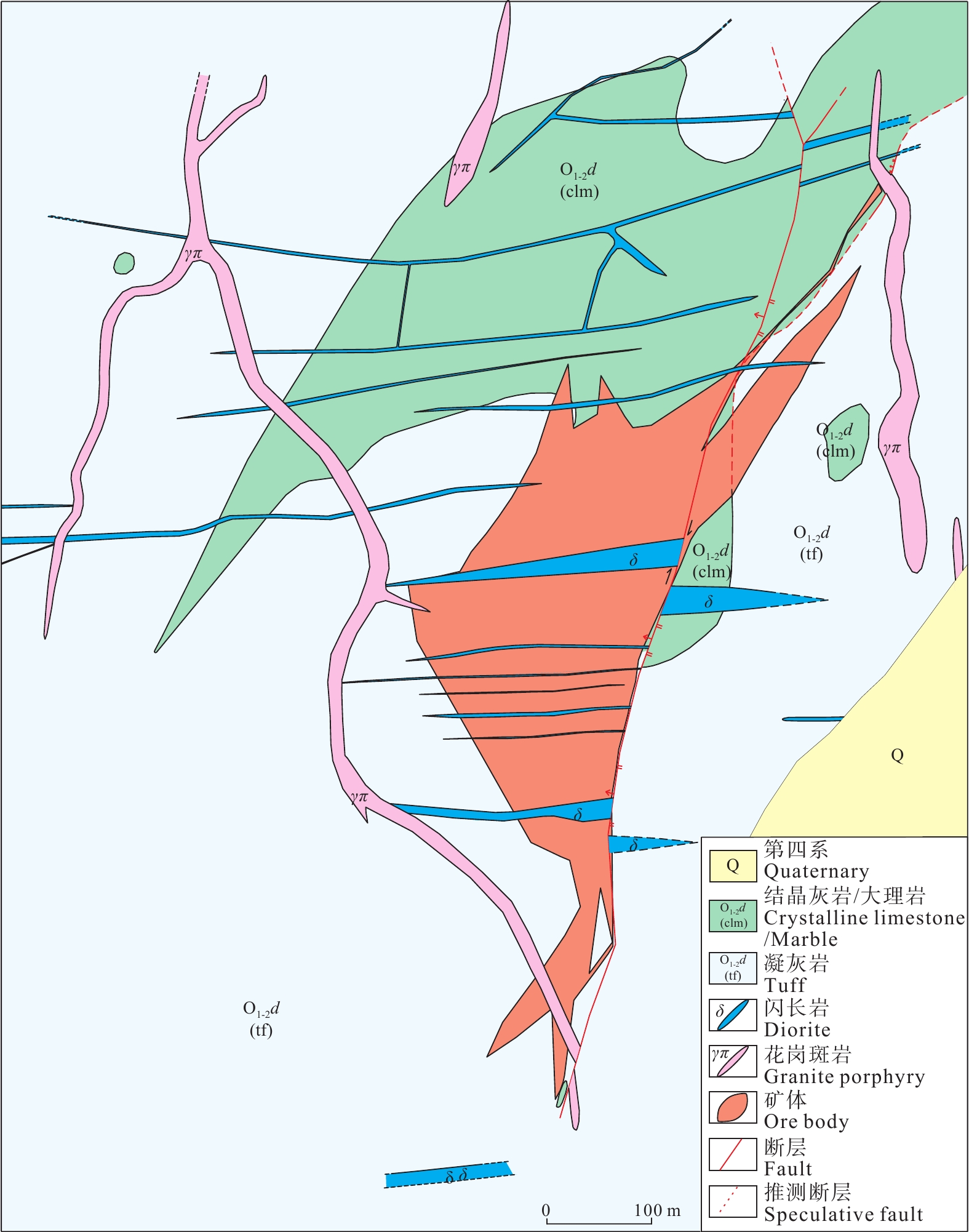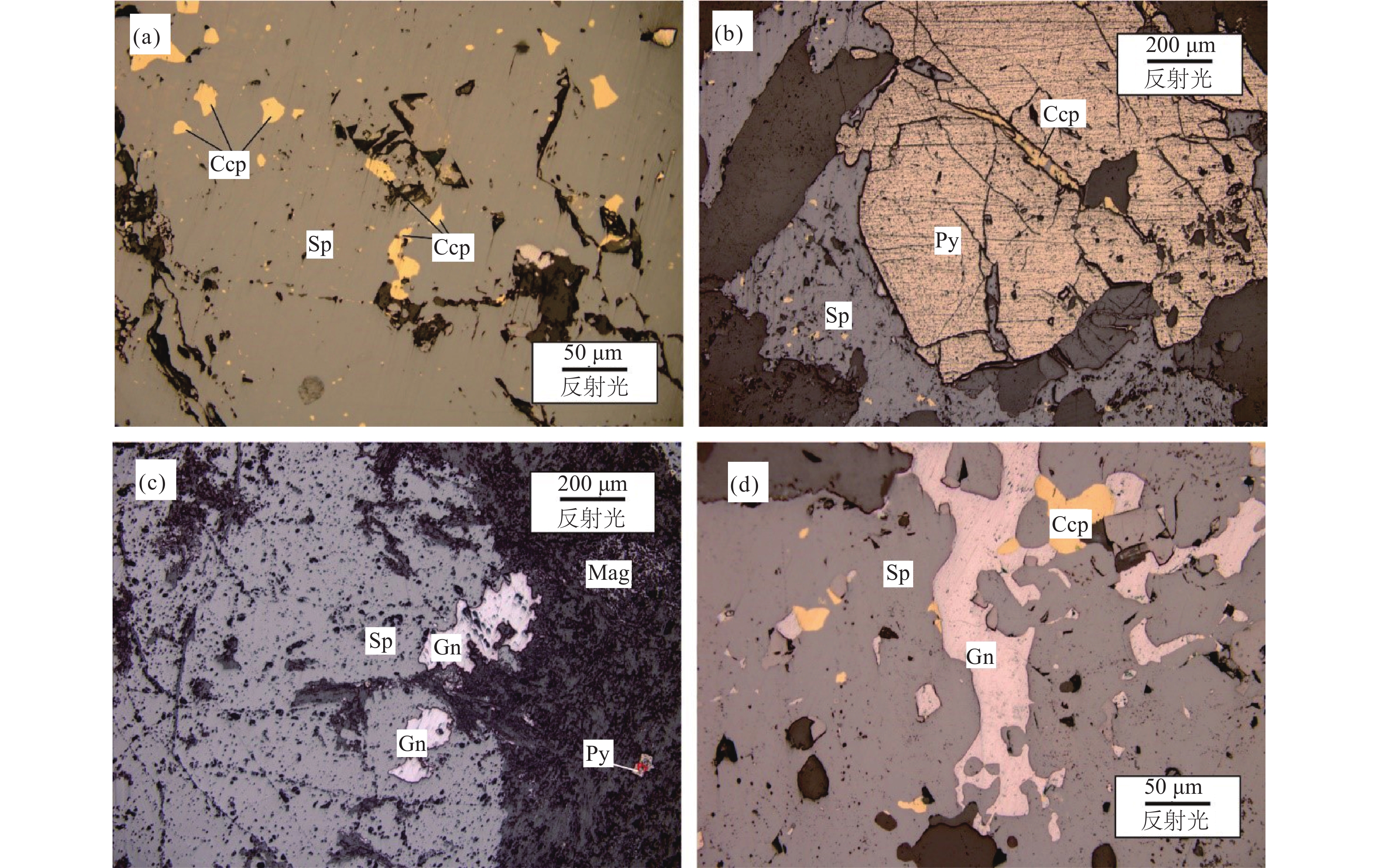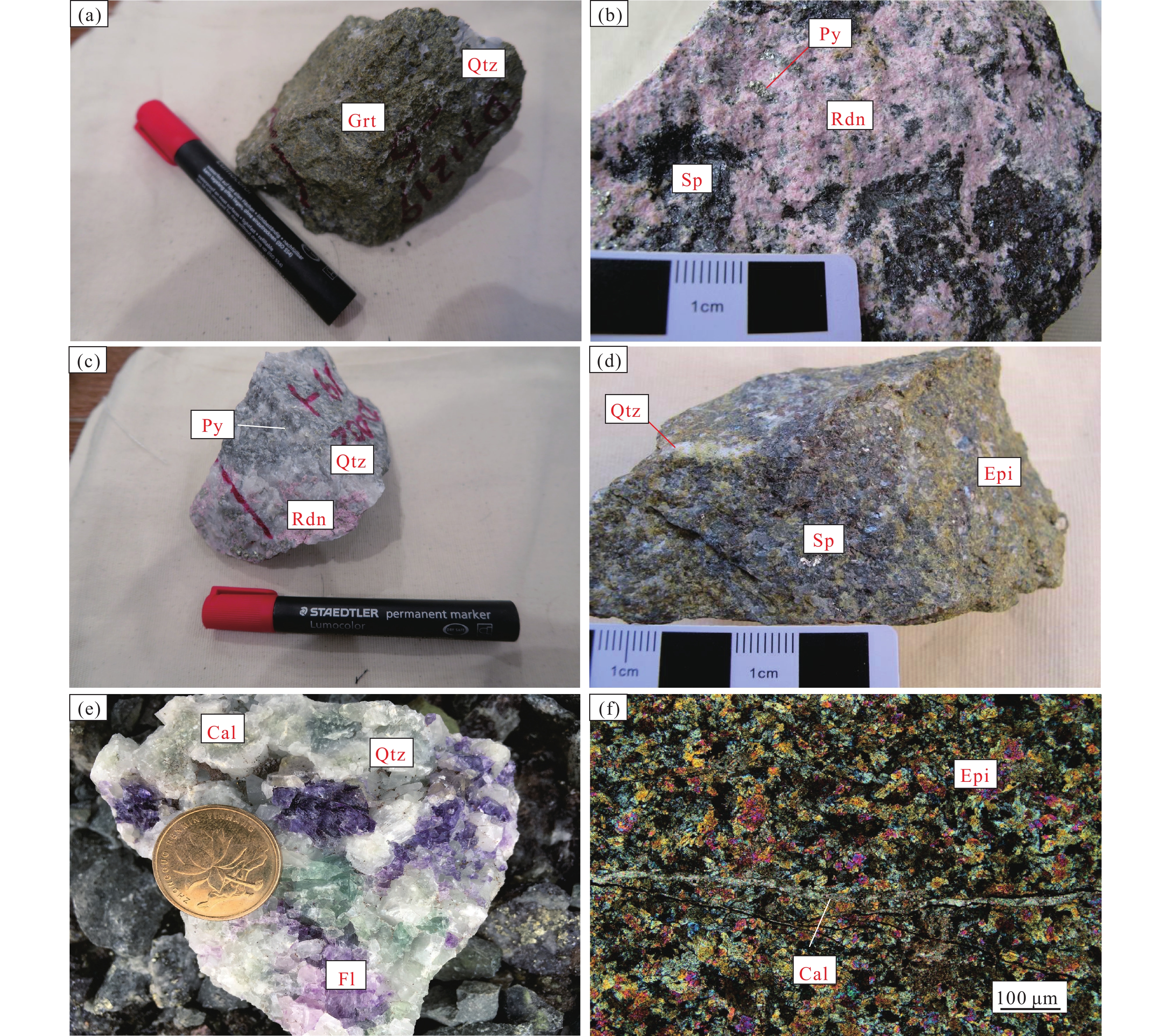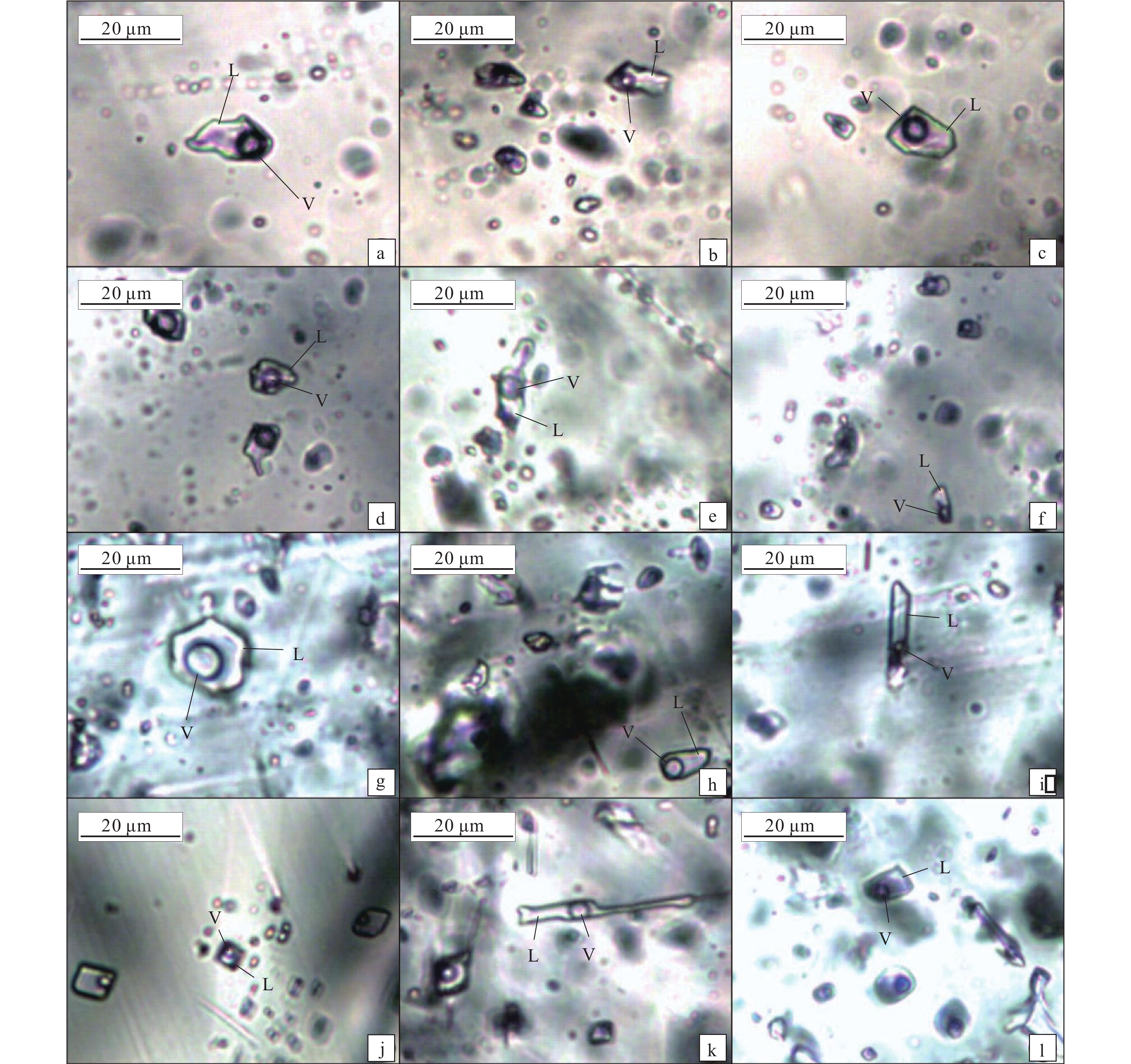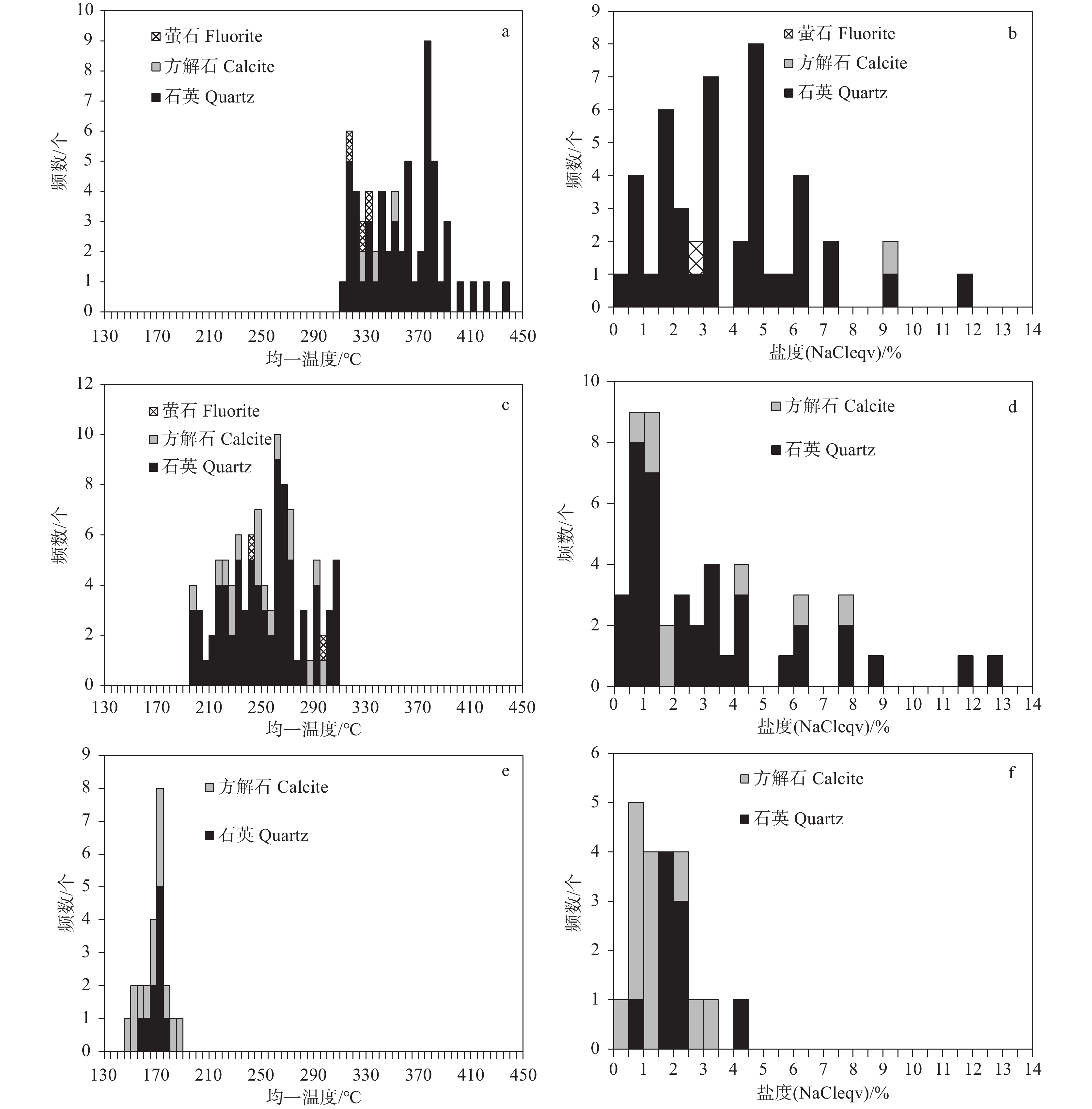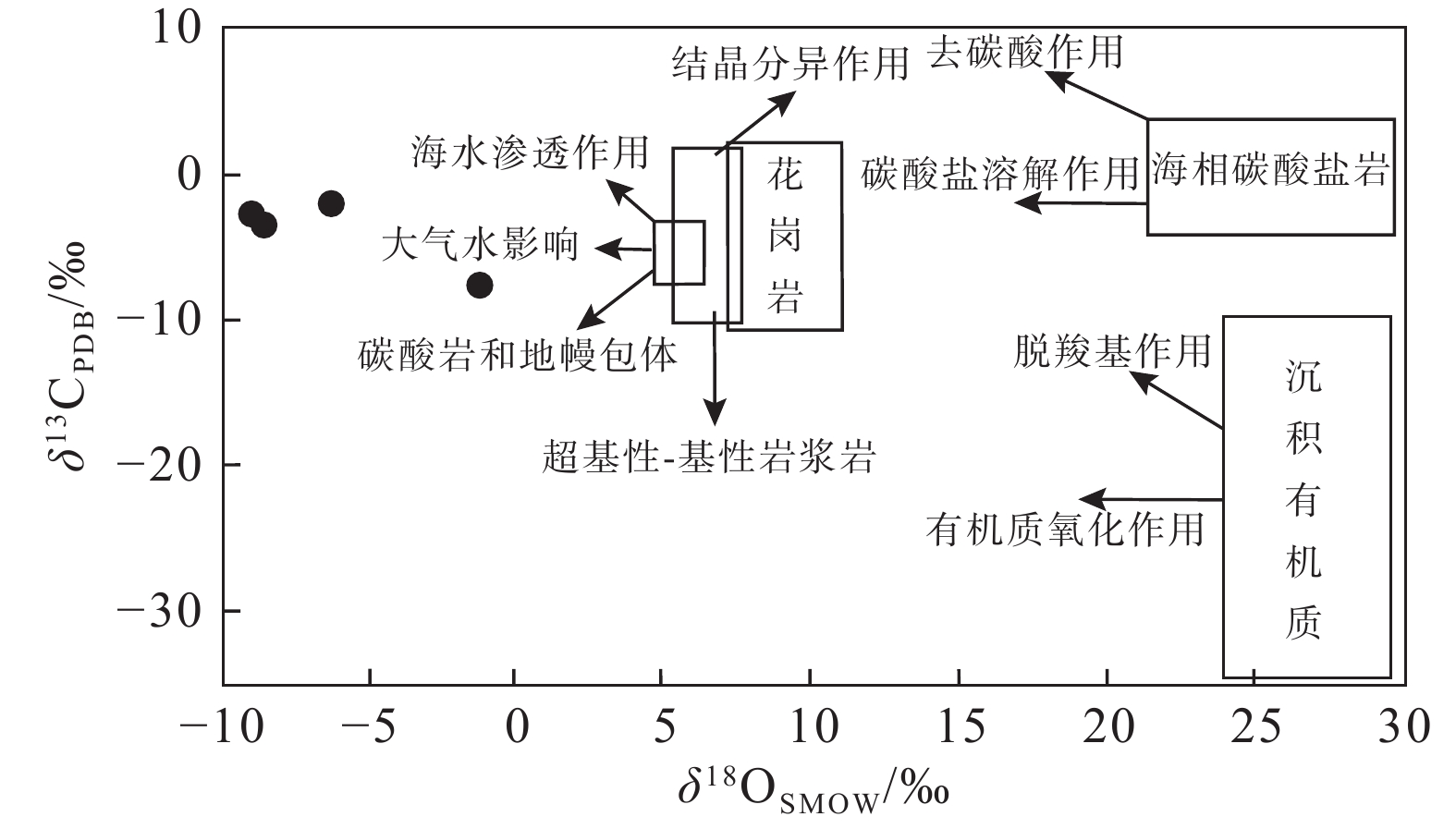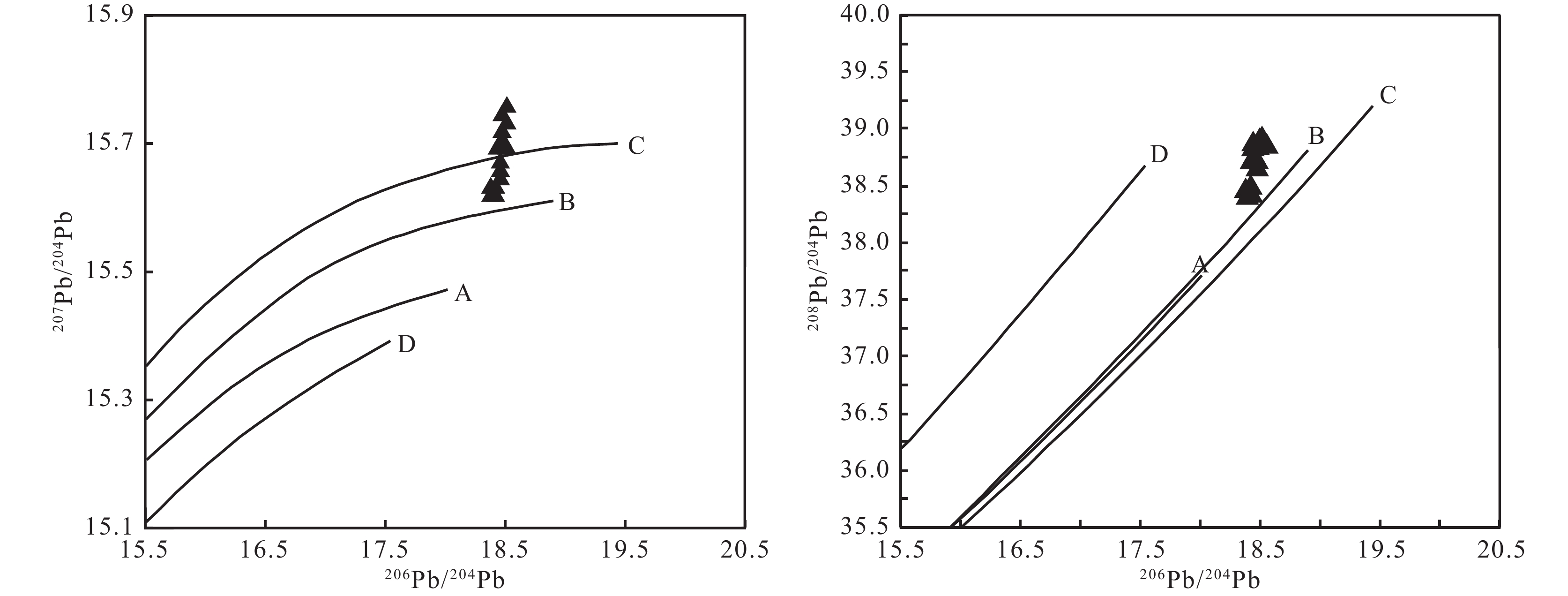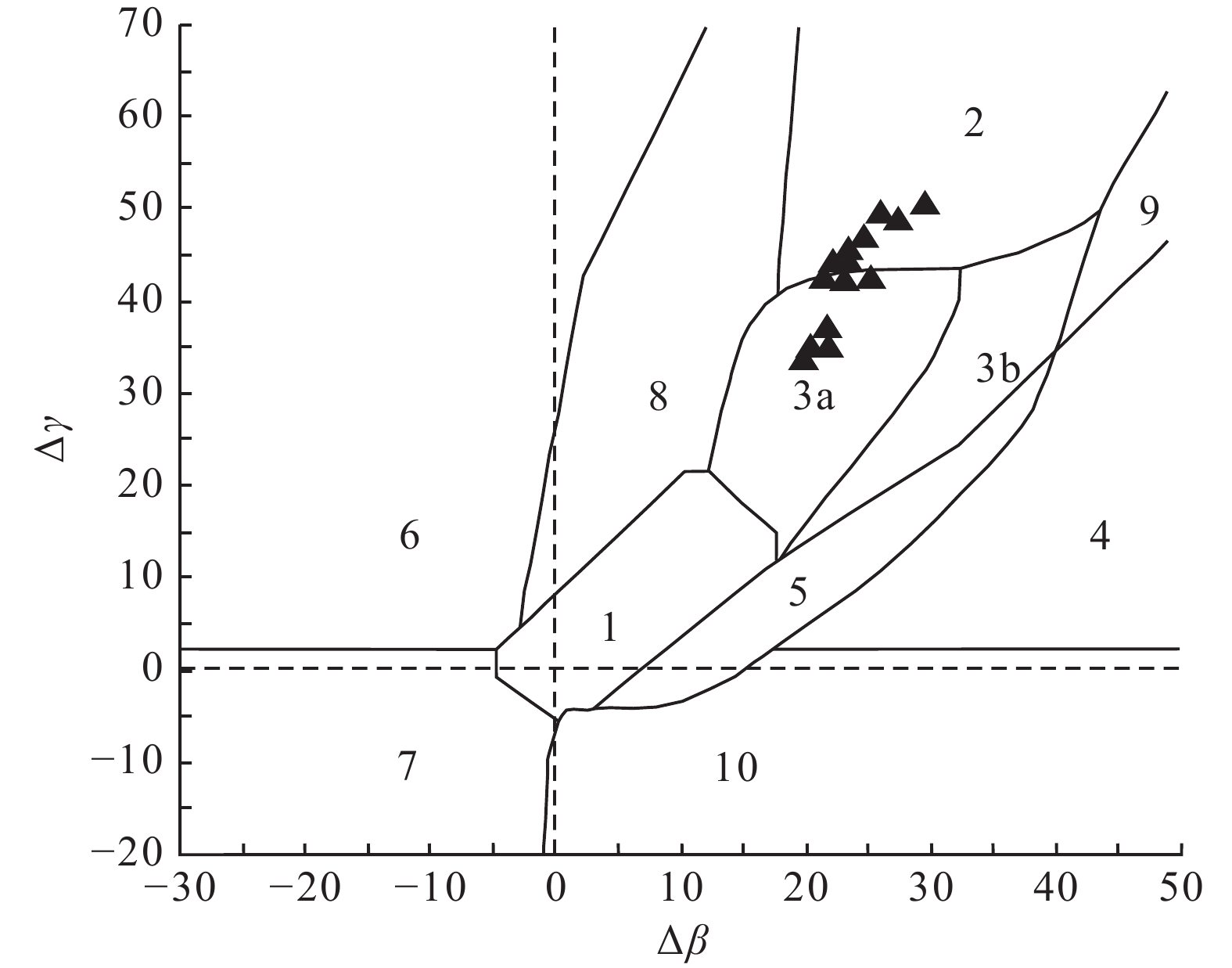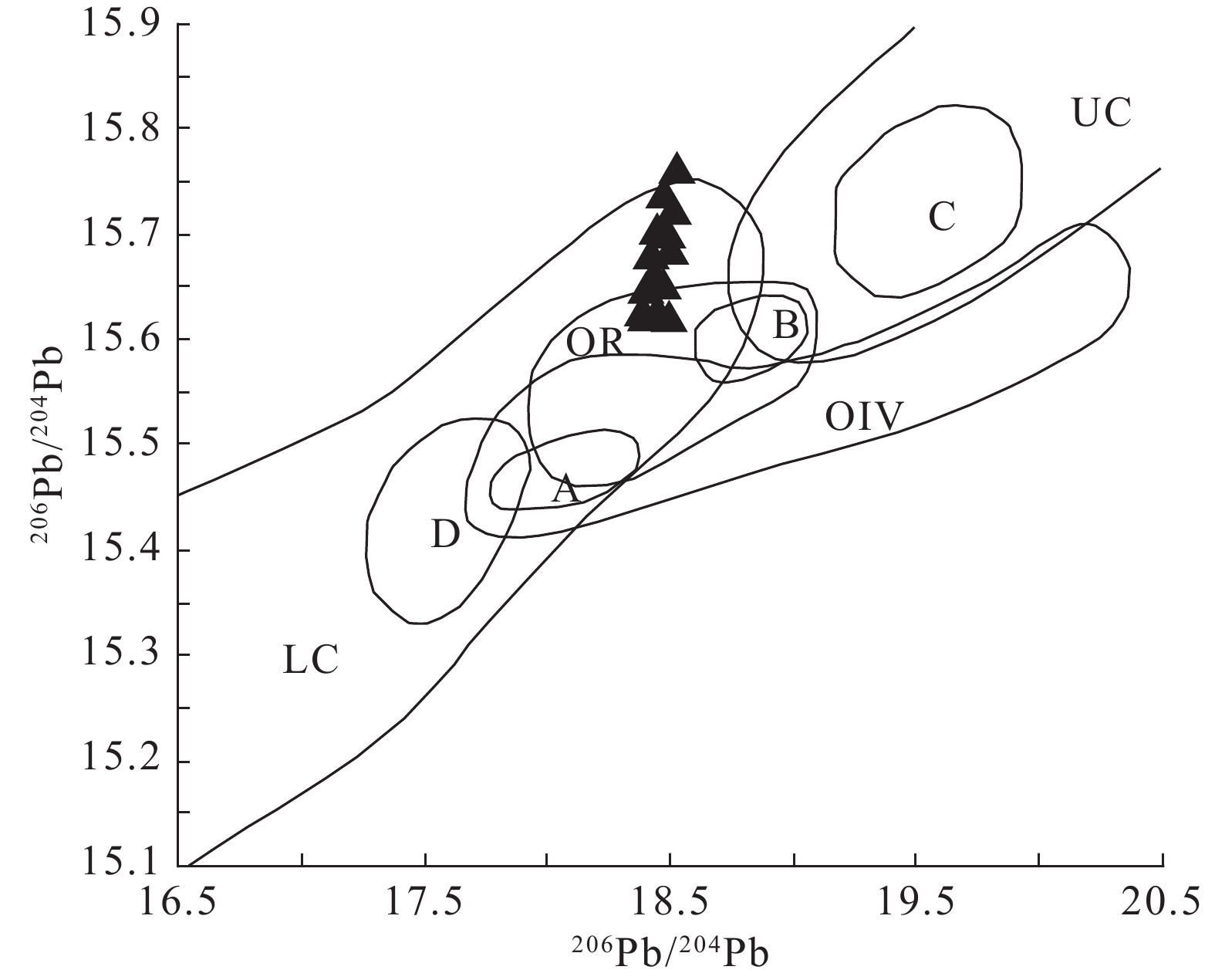Discussion on the ore−forming fluids, materials sources and genesis of Erdaohe Pb−Zn−Ag deposit, Inner Mongolia
-
摘要:研究目的
二道河铅锌银矿位于大兴安岭中段,是近年来发现的具有代表性的大型矽卡岩型矿床,通过对该矿床成因的研究将有助于指导大兴安岭中段多金属矿床的勘查工作。
研究方法本文在野外地质调查的基础上,选取各成矿阶段热液石英进行流体包裹体研究,并结合矿石S、Pb同位素与方解石C、O同位素,探讨该矿床成矿流体及物质来源。
研究结果二道河矿床先后经历了矽卡岩阶段、石英硫化物阶段、石英碳酸盐阶段。测温结果显示,热液石英中的包裹体以气液两相为主,矽卡岩阶段石英中包裹体均一温度为310~435℃,盐度为11.7%~0.71% NaCleqv;石英−硫化物阶段石英中包裹体均一温度为195~310℃,盐度为12.9%~0.35% NaCleqv;石英−碳酸盐阶段石英中包裹体均一温度为148~195℃,盐度为4.18%~0.35% NaCleqv。方解石C、O同位素显示矿床经历了水岩反应,并有大气降水的加入。矿石硫同位素δ34S为5.4‰~10.0‰,来源于岩浆与地层的混合硫;铅同位素特征参数表明,铅的来源与造山相关的岩浆作用有关,以上地壳铅为主并混合了少量的深源铅。
结论综上所述,二道河铅锌银矿的成矿流体与物质来源应与蒙古—鄂霍茨克洋闭合造山后伸展导致的大规模岩浆作用有关。
创新点:通过矿区填图、矿区剖面测量和钻孔编录等方式,在查明二道河铅锌银地质特征的基础上通过多种地球化学手段探讨矿床的成矿流体演化特征、成矿来源及成因。
Abstract:This paper is the result of mineral exploration engineering.
ObjectiveThe Erdaohe silver−lead−zinc deposit is located in the middle section of the Greater Khingan Range. It is a representative large−scale skarn−type deposit discovered in recent years. Studying the origin of this deposit will help guide the exploration of polymetallic deposits in the middle section of the Greater Khingan Range.
MethodsOn the basis of field geological survey, this paper made research on the fluid inclusion in the keatite selected at each stage of mineralization, and discussed the ore−forming fluid and material sources in combination with the S and Pb isotopes of ore and the C and O isotopes of calcite.
ResultsThe research result showed the formation of the deposit throughout the process from the skarn stage to the quarte−sulfide stage and to the quartz carbonate stage. According to the temperature measurement result, the inclusion in keatite was mainly characterized by gas−liquid phase, with the homogenization temperature of 310–435℃ at the skarn stage, 195–310℃ at the quarte−sulfide stage and 148–195℃ at the quartz carbonate stage, and the salinity of 11.7%–0.71% NaCleqv at the skarn stage, 12.9%–0.35% NaCleqv at the quartz−sulfide stage and 4.18%–0.35% NaCleqv at the quartz−carbonate stage. The C and O isotopes of calcite indicated a water−rock reaction of the deposit, in which atmospheric precipitation was found. The δ34S value of the S isotope of ore was 5.4‰–10.0‰ from a mixture of sulfurs in magma and strata; as per the characteristic parameter of lead isotope, the source of lead was associated with the orogeny−related magmatism, where the lead was mostly from the upper crust, and slightly from the deep source.
ConclusionsAccordingly, the ore−forming fluid and material sources were considered the products of the large−scale magmatism caused by the extension after the closure of Mongolia−Okhotsk for orogeny.
Highlights:Through methods such as geological mapping, orebody profiling, and drillhole logging, we clarify the geological characteristics of the Erdaohe lead−zinc−silver deposit. Based on this understanding, various geochemical techniques will be employed to explore the characteristics of ore−forming fluid evolution, the origin of mineralization, and the genesis of the deposit.
-
1. 引言
石泉–旬阳金矿带整装勘查区7个图幅区1∶50 000水系沉积物测量始于2013年(图1),其中饶峰幅、迎丰街幅和安康幅1∶50 000水系沉积物测量由中国地质调查局发展研究中心2016—2018年组织实施;铁佛寺幅、汉阴幅、大河口幅和赵家湾幅1∶50 000水系沉积物测量由中国地质调查局西安地质调查中心2013—2015年组织实施,承担单位均为陕西地矿第一地质队有限公司。
陕西石泉–旬阳金矿带整装勘查区位于秦岭造山带中部的南秦岭构造带,在漫长地质历史演化中,该区地层经历了多期变形,构造样式以褶皱、滑脱和韧性剪切带最为典型。地层区划隶属于华南地层大区中的牛山地层小区(韩芳林等,2013)(图2)。因盖层与基底间拆离滑脱,以出露滨海环境下形成的震旦纪—早古生代黑色浅变质强变形细碎屑岩系建造最为典型(张复新等,2009;唐永忠等,2012)。区内出露地层有古元古代杨坪岩组、耀岭河岩组中基性火山岩,古生代沉积—浅变质岩,中晚志留世—早泥盆世沉积地层发育不全(刘国惠和张寿广,1993)。
石泉–旬阳金矿带整装勘查区1∶50 000水系沉积物测量从2013年7月份编写项目设计书开始,各项工作均按相关技术要求执行。项目总体按三个阶段进行,第一阶段组织地球化学勘查技术人员进行1∶50 000水系沉积物测量采样工作;第二阶段检查、核对、整理和处理数据,圈定地球化学异常;第三阶段编制地球化学系列图件,建立完善石泉–旬阳金矿带整装勘查区的区域地球化学数据库,筛选并进行异常查证工作。
陕西石泉–旬阳金矿带整装勘查区水系沉积物测量原始数据集元数据简表见表1。
表 1 数据库(集)元数据简表条目 描述 数据库(集)名称 陕西石泉–旬阳金矿带整装勘查区饶峰幅等7个图幅区1∶50 000水系沉积物测量原始数据集 数据库(集)作者 谈 乐,陕西地矿第一地质队有限公司
张永强,陕西地矿第一地质队有限公司
刘小朋,陕西地矿第一地质队有限公司
李小明,陕西地矿第一地质队有限公司
王才进,陕西地矿第一地质队有限公司数据时间范围 2013—2018年 地理区域 陕西省石泉县–旬阳县地区 数据格式 *.xlsx 数据量 2.01MB 数据服务系统网址 http://dcc.cgs.gov.cn 基金项目 中国地质调查局地质调查项目(121201004000150017-53、121201004000160901-54、121201004000172201-45、12120113048100) 语种 中文 数据库(集)组成 数据集为Excel表格,包括7个独立的工作表(sheet),分别为“饶峰幅采样点位及元素分析结果表”、“铁佛寺幅采样点位及元素分析结果表”、“汉阴幅采样点位及元素分析结果表”、“大河口幅采样点位及元素分析结果表”、“赵家湾幅采样点位及元素分析结果表”、“迎丰街幅采样点位及元素分析结果表”、 “安康幅采样点位及元素分析结果表” 2. 野外工作方法
2.1 方法选择
勘查区属湿润−半湿润中低山丘陵自然景观区(樊会民和李方周,2013),湿润、多雨、强剥蚀、深切割,以物理风化为主,沟系冲、洪积物具粗岩屑性质(刘劲松等,2016),适宜开展水系沉积物测量。根据《地球化学普查规范(1∶50 000)》(DZ/T 0011−2015),结合勘查区地球化学景观特点,确定本次地球化学普查采样介质为水系沉积物,采样密度4~8点/km2,样品粒级选择−20目~+60目。
2.2 样品采集
2.2.1 采样部位
勘查区1∶50 000水系沉积物测量采样部位均选择在河沟底部或河岸与水面接触处(张源等,2018)。在间歇性水流地区或主干河道中,主要在河床底部采样;在水流湍急的河道中选择在水流变缓处、水流停滞处、转石背后、水流由窄变宽处,以及河道转弯内侧有较多细粒物质聚集处采样。
2.2.2 采样物质
采样介质以代表原生地质找矿信息的基岩物质成分为原则,采样物质为水系沉积物中的淤泥、粉砂或细砂。
2.2.3 采样方法
勘查区水系沉积物所采集的样品为粗−细粒级混合的粒级段,有效地避开了腐植层取样,样品采集过程中,加强了对蚀变−矿化强烈或重点找矿地段的加密采样工作。采用的具体技术方法如下:
①采样前,先用采样勺拨去地表浮土或腐植层,再进行取样。
②每次装袋前,首先检查布样袋,看是否有开线或破洞。含水样品装袋时先用塑料袋分装后再装入布样带中,防止袋内水分相互淋滤造成湿样互相污染。
③为了提高样品的代表性,样品采集均在采样点位上下游20~30 m范围内3~5处多点采集,组合成一件样品。
④样品采集避开了矿山开发、村镇、水坝、淤地造田、交通要道和路口造成的污染物及岸边崩塌堆积物地段。
2.2.4 野外定点
陕西石泉–旬阳金矿带整装勘查区涉及1∶50 000图幅共7幅(表2),图幅坐标系采用1980西安坐标系,中央经线为111°,图幅涉及地理数据均在陕西地理信息测绘局购买。
表 2 陕西石泉−旬阳金矿带整装勘查区涉及的7幅1∶50 000地形图图幅名称 图幅号 饶峰幅 I49E17001 迎丰街幅 I49E18002 铁佛寺幅 I49E18003 汉阴幅 I49E19003 大河口幅 I49E19004 赵家湾幅 I49E19005 安康幅 I49E02005 用1∶50 000标准地形图作为水系沉积物测量野外工作手图,采用手持IGS-100掌上机(李超岭等,2002)结合地形图进行野外定点。定点实际距离误差均小于30 m,即在手图上均小于1 mm。
2.3 采样点密度
本次共采集水系沉积物样品13 169件。根据勘查区地形地貌特点、景观条件、地质特征,本次1∶50 000水系沉积物测量分别采用了不同的采样布局和采样密度:加密区(即指1∶200 000化探异常明显、矿化信息相对较多、基岩面积大、第四系分布面积较少的地区,除正常布点外,成矿有利地段适当加密)采样密度为5.18~5.46点/km2;一般工作区(即指第四系分布面积相对较多,基岩出露面积小或零星,1∶200 000化探异常弱的地区)采样密度为:4.1~4.3点/km2;放稀区(即山间盆地)采样密度为3.13~3.52点/km2。该采样密度组合可有效地控制工作区内绝大多数汇水面积,经济实用,可有效地达到地球化学普查的目的。
2.4 样品加工
样品加工基本流程为:自然干燥→揉碎→过筛→混匀→称量缩分→填写标签→装袋→填写送样单→装箱(陈玉明和陈秀法,2018)。
样品干燥方式采取日晒风干。干燥过程中及时揉搓样品,防止结块,并用木槌适当敲打。
② 样品干燥后过−20目~+60目尼龙筛,对筛下样品用对角线折叠法混匀,缩分后装入纸样袋中,其重量均≥310 g。
③按样品缩分法将加工好的样品缩分成两份各≥150 g,一份装牛皮纸袋送检,另一份装塑料瓶封装当副样留存。
3. 样品分析测试方法
样品分析测试工作先后由具备岩矿测试甲级资质的自然资源部西安矿产资源监督检测中心和陕西地矿局汉中地质大队有限公司实验室承担,严格执行《地球化学普查(比例尺1∶50 000)规范样品分析技术的补充规定》。
3.1 实验室样品加工与制备
实验室配备有专职样品管理人员,负责样品的验收和保管,并严格按照规范要求办理样品交接手续。
以50件样品为一个分析批次进行编码和样品加工,每一个分析批次中随机插入4个国家一级标准物质,然后进入计算机,打印出分析号与送样号的对照表,以供样品管理人员在管理样品、填写汇总表等准备工作中使用,样品随后由样品管理人员下达至碎矿间进行无污染碎样。
化探样品在加工前均在60℃以下充分烘干。在大批量样品加工前,先对岩屑样分别进行玛瑙球数量、球磨时间的最佳条件试验,使其细磨后样品粒度满足1∶50 000区域地球化学调查的要求为原则。要求细磨加工后样品粒度达到−0.074 mm(−200目)占90%以上。
样品管理人员对每批样品的加工粒度是否达到规定要求进行检查;检查合格后,按规定插入指定的监控样及国家一级标样,同时依照密码编号分出内检样,随后交由质量管理人员下达分析任务。
3.2 分析项目及分析方法
根据项目任务书、合同书及总体设计要求,2013—2015年度 1∶50 000水系沉积物测量分析项目为:Au、Ag、Cu、Pb、Zn、As、Sb、Hg、V、Mo、Ti、W共12种元素。2016—2018年度1∶50 000水系沉积物测量分析项目为Au、Ag、Cu、Pb、Zn、As、Sb、Hg、Bi、Sn、W、Mo、Cd、Co、Cr、Ni共计16种元素。
采用光栅光谱仪(OES)、原子荧光仪(AFS)、等离子质谱仪法(ICP-MS)、发射光谱法(GF-AAS)等仪器进行分析测试,所有元素报出率均为100%。勘查区18种元素分析测试方法配套方案见表3。
表 3 勘查区18种元素分析方法、检出限及报出率统计表分析方法 元素含量 1∶50 000地球化学测量规定检出限 所用方法检出限 报出率(%) GF-AAS w(Au)/10−9 0.3~1 0.23 100 F-AAS w(Cu)/10−6 2 1.00 100 w(Zn)/10−6 20 5.00 100 HG-AFS w(As)/10−6 0.5~1 0.20 100 w(Sb)/10−6 0.3 0.05 100 CV-AFS w(Hg)/10−9 10~50 2.00 100 w(Bi)/10−6 0.3 0.1 100 ICP-OES w(Ti)/10−6 100 9.3 100 w(V)/10−6 20 5 100 OES w(Ag)/10−6 0.050 0.019 100 w(Sn)/10−6 2 0.5 100 ICP-MS w(Pb)/10−6 5~10 0.91 100 w(W)/10−6 1 0.048 100 w(Mo)/10−6 1 0.056 100 w(Ni)/10−6 1 0.21 100 w(Co)/10−6 1 0.10 100 w(Cr)/10−6 10 1.00 100 w(Cd)/10−6 0.2 0.02 100 4. 数据样本描述
石泉–旬阳金矿带整装勘查区饶峰幅等7个图幅1∶50 000水系沉积物测量原始数据集为Excel表格型数据,包括7个独立的工作表(sheet),分别为“饶峰幅水系沉积物测量采样点位及元素分析结果表”、“迎丰街幅水系沉积物测量采样点位及元素分析结果表”、“铁佛寺幅水系沉积物测量采样点位及元素分析结果表”、“汉阴幅水系沉积物测量采样点位及元素分析结果表”、“大河口幅水系沉积物测量采样点位及元素分析结果表”、“赵家湾幅水系沉积物测量采样点位及元素分析结果表”、“安康幅水系沉积物测量采样点位及元素分析结果表”(宋相龙等,2017)。每个工作表(sheet)包含如下内容:样品编号、高斯坐标、图幅号、地层、分析结果(铁佛寺幅、大河口幅、汉阴幅、赵家湾幅分析元素为Au、Hg、Ag、Cu、Pb、Zn、Mo、As、Sb、Ti、V、W;迎丰街幅、饶峰幅、安康幅分析元素为Au、Ag、Cu、Pb、Zn、As、Sb、Hg、Bi、Sn、W、Mo、Cd、Co、Cr、Ni)、备注。数据结构见表4。
表 4 陕西石泉−旬阳金矿带整装勘查区水系沉积物测量数据结构表序号 数据项名称 量纲 数据类型 字段长度 实例 1 样品编号 − 字符型 20 57C2 2 图幅号 − 字符型 20 I49E018002 3 地层 − 字符型 20 O3-S1b 4 高斯横坐标 − 字符型 20 255460 5 高斯纵坐标 − 字符型 20 3672075 6 经度 − 字符型 20 108°22′45″ 7 纬度 − 字浮型 20 33°08′48″ 8 Au 10−9 浮点型 20 1.03 9 Ag 10−6 浮点型 20 42 10 Cu 10−6 浮点型 20 35.9 11 Pb 10−6 浮点型 20 35.9 12 Zn 10−6 浮点型 20 83.7 13 As 10−6 浮点型 20 3.88 14 Sb 10−6 浮点型 20 2.13 15 Hg 10−9 浮点型 20 49 16 Bi 10−6 浮点型 20 0.85 17 Sn 10−6 浮点型 20 3 18 W 10−6 浮点型 20 2.14 19 Mo 10−6 浮点型 20 0.93 20 Cd 10−6 浮点型 20 0.1 21 Co 10−6 浮点型 20 22.3 22 Cr 10−6 浮点型 20 94.6 23 Ni 10−6 浮点型 20 41.9 24 Ti 10−6 浮点型 20 − 25 V 10−6 浮点型 20 − 5. 数据质量和评估
5.1 原始数据质量
铁佛寺幅、汉阴幅、大河口幅和赵家湾幅地球化学测量样品测试过程中以50件样品为一个分析批次进行编码和样品加工,每一个分析批次中随机插入4个国家一级标准物质,分别为GBW07302a、GBW07304a、GBW07309、GBW07318,对分析过程的精密度进行监控。另外随机分段加入12件国家一级标准物(每500件样品插入一次),共插入15次,对分析过程的准确度进行监控,并对样品中部分高值和低值进行了抽查分析,抽查样品数量比例为2.6%。
饶峰幅、迎丰街幅和安康幅地球化学测量样品测试过程中以50件样品为一个分析批进行编码和样品加工,共分为243批。每一个分析批次中随机插入购买于中国地质科学院地球物理地球化学勘查研究所的4个国家一级标准物质对分析过程的准确度进行监控。其中Au、Ag、Hg、Pb、Sn、As、Sb和Bi共8种元素插入GSD-10、GSD-14、GSD-18、GSD-20控制分析过程精密度;Cr、Co、Ni、Cu、Zn、Mo、Cd和W共8种元素插入GSD-8a、GSD-9、GSD-10、GSD-14控制分析过程精密度,并对样品中部分高值和低值进行了抽查分析,抽查样品数量比例为4.1%。
本次检测工作中,分析元素内检(重复样)合格率均在95.00%以上;元素报出率均达到100%;元素异常复查合格率均为97.5%以上;所选用分析方法的检出限均满足DZ/T0130.4−2006中1∶50 000化探样品标准要求。方法的精密度:对所选一级标准物质检测的△lgC平均值在(−0.099~0.099)以内。方法准确度:对所选一级标准物质检测的△lgC平均值在(−0.099~0.099)以内。所选分析方法的检出限、精密度和准确度均满足《地球化学普查(比例尺1∶50 000)规范样品分析技术的补充规定》的质量要求。
上述质量参数数据表明,本次检测的分析质量完全符合《地球化学普查(比例尺1∶50 000)规范样品分析技术的补充规定》及DZ0130.4−2006的质量要求。
5.2 成果数据库建设质量
陕西石泉–旬阳金矿带整装勘查区饶峰幅等7个图幅区1∶50 000水系沉积物测量成果数据库建设(万常选等,2009)均按照化探数据模型采用DGSS软件平台实现(庞健峰等,2017),样品中各分析元素属性结构均参照中国地质调查局固体矿产勘查数据库内容与结构(左群超等,2018;李超岭等,2013)填写,数据结构内容完整齐全。所形成的7幅1∶50 000水系沉积物测量数据库已由中国地质调查局西安地质调查中心及中国地质调查局发展研究中心专家评审验收,评分93分,评为“优秀级”,已完成相关数据库汇交。
6. 结论
本次数据集工作区范围是由中国地质调查局西安地质调查中心与中国地质调查局发展研究中心组织实施的陕西石泉–旬阳金矿带整装勘查区内饶峰幅等7幅图3 010 km2 1∶50 000水系沉积物测量工作,是陕西石泉–旬阳金矿带整装勘查区内首次系统性的采用统一采样方法、分析测试方法、统一分析元素,也是本整装勘查区内首次规范化建立地球化学数据库,获得了珍贵的第一手地球化学测量资料。
本数据集成果指导在整装勘查区内圈定金找矿靶区10处,金成矿远景区12处❶,其中在圈定的陕西省汉阴县双河口一带金找矿靶区内新发现坝王沟金矿点,通过后期省地勘基金投入,金(333+334)资源量30吨;在圈定的陕西省安康市汉滨区将军山一带金找矿靶区内新发现早阳金矿点,通过后期省地勘基金投入,金(333+334)资源量20吨。另外运用本数据集成果新发现4处金矿点,分别为陕西省宁陕县堰沟金矿点、陕西省安康市汉滨区柳坑金矿点、陕西省石泉县石桥金矿点、陕西省石泉县栈房金矿点,均有一定的找矿潜力。另外,本数据集成果指导我省找到2~4处新的大型金矿产资源开发基地。
注释:
❶张永强, 孙健, 谈乐. 2018. 陕西石泉−旬阳金矿带整装勘查区矿产调查与找矿预测2016—2018年子项目总成果报告[R]. 安康:陕西地矿第一地质队有限公司, 1−260.
1. Introduction
The measurement of 1∶50 000 stream sediments across 7 map sheets of the integrated survey area of the Shiquan-Xunyang gold zone began in 2013 (Fig. 1), of which those in the Raofeng, Yingfengjie and Ankang map sheets were organized by the Development and Research Center of China Geological Survey in 2016—2018; those in the Tiefosi, Hanyin, Dahekou and Zhaojiawan map sheets were organized by the Xi’an Center of China Geological Survey in 2013—2015, and both were conducted by the Team No.1, Shaanxi Bureau of Geology and Mineral Resources Co. Ltd..
The integrated survey area of the Shiquan-Xunyang gold ore zone, Shaanxi, located at the South Qinling tectonic zone in the midst of the Qinling orogeny, has experienced multi-stage deformations in its long history of geological evolution, where the typical tectonic patterns are folding, detachment and ductile shearing zones. In terms of stratigraphic regionalization, it belongs to the Niushan stratigraphic sub-region of the South China stratigraphic super-region (Han FL et al., 2013) (Fig. 2). Due to decoupling detachment between the overlying strata and basement, the outcrop in the area is characterized by the formation of Sinian−early-Paleozoic, black, low-metamorphic, strongly-deformed fine clastic rock series, which were formed in the coastal sea environment (Zhang FX et al., 2009; Tang YZ et al., 2012). The outcropped strata within the area include the Paleoproterozoic Yangpingyan Formation, the basic volcanic rock of the Yaolinghe Formation and Paleozoic sedimentary−low-metamorphic rocks, where mid- and late-Silurian−early-Devonian sedimentary strata are poorly developed (Liu GH and Zhang SG, 1993).
The measurement of the 1∶50 000 stream sediments in the integrated survey area of the Shiquan-Xunyang gold ore zone began with preparation of the project design in July 2013, all works being done in accordance with the relevant technical specifications. The project was completed in three stages: Stage 1, organization of the geochemical staff to take samples for the measurement of the 1∶50 000 stream sediments; Stage 2, checking, verifying, collating and processing data, and delineation of geochemical anomalies; Stage 3, plotting a series of geochemical maps, establishing and improving the regional geochemical database for the integrated survey area of the Shiquan-Xunyang gold ore zone, and screening and verifying anomalies.
Metadata for the measured original dataset of the stream sediments in the 7 map sheets of the integrated survey area of the Shiquan-Xunyang gold ore zone, Shaanxi, are shown in Table 1.
表 1 Metadata Table of Database (Dataset)Items Description Database (dataset) name The 1∶50 000 Original Measurement Dataset on Stream Sediments for 7 Map Sheets including the Raofeng Map in the Integrated Survey Area of the Shiquan-Xunyang Gold Ore Zone, Shaanxi Database (dataset) authors Tan Le, Team No.1, Shaanxi Bureau of Geology and Mineral Resources Co. Ltd.
Zhang Yongqiang, Team No.1, Shaanxi Bureau of Geology and Mineral Resources Co. Ltd.
Liu Xiaopeng, Team No.1, Shaanxi Bureau of Geology and Mineral Resources Co. Ltd.
Li Xiaoming, Team No.1, Shaanxi Bureau of Geology and Mineral Resources Co. Ltd.
Wang Caijin, Team No.1, Shaanxi Bureau of Geology and Mineral Resources Co. Ltd.Data acquision time 2013—2018 Geographic area Shiquan-Xunyang, Shaanxi Data format *.xlsx Data size 2.01MB Data service system URL http://dcc.cgs.gov.cn Fund project China Geological Survey Project (121201004000150017-53, 121201004000160901-54, 121201004000172201-45, 12120113048100). Language Chinese Database(dataset) composition The dataset consists of 7 separate Excel sheets: Raofeng Sampling Points and Element Analytical Result Sheet, Tiefosi Sampling Points and Element Analytical Result Sheet, Hanyin Sampling Points and Element Analytical Result Sheet, Dahekou Sampling Points and Element Analytical Result Sheet, Zhaojiawan Sampling Points and Element Analytical Result Sheet, Yingfengjie Sampling Points and Element Analytical Result Sheet and Ankang Sampling Points and Element Analytical Result Sheet. 2. Field Work Methods
2.1 Selection Method
The survey area is a humid−semihumid mid-and-low hilly natural landscape area (Fan HM and Li FZ, 2013), humid, rainy, strongly denuded, deeply cut, mainly physically-weathered, where channel-system alluvium and diluvium have the properties of coarse debris, suitable for the measurement of the stream sediments (Liu JS et al., 2016). In accordance with the Specifications of the Geochemical Reconnaissance Survey (1∶50 000)(DZ/T 0011−2015), considering the geochemical landscape features of the survey area, it was decided to use stream sediment as the medium to be sampled for this geochemical reconnaissance survey, at a sampling density of 4~8 points/km2, and –20 meshes ~ +60 meshes are selected for the sample’s grain size.
2.2 Sampling
2.2.1 Sample Location
In the survey area, samples for measurement of 1∶50 000 stream sediments are all taken from the river bottom or the contact between the riverbank and the water surface (Zhang Y et al., 2018). In intermittent or trunk river channels, samples are mainly taken from the bottom of the riverbed; in rivers with rapid flow, samples are taken at places where water flows slowly or stops, or behind a boulder, or where water flow widens, or at the inner side of the turn of the river channel, where much more fine-grained materials concentrate.
2.2.2 Sampling Materials
Following the principle that sampled media shall represent material components of bedrocks containing original geological prospecting information, sampling materials are sludge, silt or fine sand in stream sediments.
2.2.3 Sampling Methods
Samples taken from the stream sediments in the survey area are graded sections, mixing coarse−fine-grain sizes, care being taken to avoid sampling from the humus layer. During sampling, an emphasis was placed on taking more samples at places where alteration−mineralization is strong, or which are priorities for prospecting. Samples are taken using the specific technique below:
① Prior to sampling, the topsoil or humus layer is removed with a sampling spoon.
② The cloth bag used for housing samples is checked to ensure that it does not have split seams or broken holes before placing samples within it. Before putting moist samples in the bag, they were placed in a plastic bag and then in the cloth bag, to prevent samples from becoming wet and contaminated, due to mutual leaching.
③ To make samples more representative, samples were taken at multiple points of 3~5 places 20~30 m within upstream and downstream of the sampling points and then combined into one sample.
④ Sampling avoids locations where there are pollutants and accumulated collapses at the bank due to mine development, villages and towns, dams, field-making from silty land, traffic route or road junctions.
2.2.4 Point Fixation in the Field
The integrated survey area of the Shiquan-Xunyang gold ore zone, Shaanxi, involves seven 1∶50 000 map sheets (Table 2) in which the 1980 Xi’an coordinate system is used and the central meridian is 111°, and geological data involved in the map sheets were purchased from the Shaanxi Geographic Information Survey Bureau.
表 2 Topographic map of seven 1∶50 000 Map Sheets involved in the Integrated Survey Area of the Shiquan-Xunyang Gold Ore Zone, ShaanxiMap sheet name Map sheet number Raofeng I49E17001 Yingfengjie I49E18002 Tiefosi I49E18003 Hanyin I49E19003 Dahekou I49E19004 Zhaojiawan I49E19005 Ankang I49E02005 The 1∶50 000 standard topographic map is used as a base map for field measurement of the stream sediments to determine the sampling points in the field with a hand-held IGS-100 device (Li CL et al., 2002). Errors in point localization were less than 30 m from their actual locations, i.e. less than 1 mm on the base map.
2.3 Density of Sampling Points
During the project there were 13 169 samples in total taken from stream sediments. Based on topographic and landform characteristics, landscape conditions and geological features, for the measurement of these 1∶50 000 stream sediments, different sampling layouts and densities were used: at the densest area (i.e. referring to areas where at 1∶200 000 a geochemical anomaly is obvious, there was more information on mineralization, larger in the bedrock area and distributed with less Quaternary strata, and in addition to normal point arrangements, sampling in sections favoring metallogenesis are undertaken to the standard density), the sampling density was 5.18~5.46 points/km2; at the ordinal work area (i.e. referring to areas where there are more Quaternary strata, smaller or sporadic outcropped bedrocks, and the 1∶200 000 geochemical anomaly is weak), the sampling density was 4.1~4.3 points/km2; at the scattered area (i.e. intermountain basin), the sampling density was 3.13~3.52 points/km2. The combination of these sampling densities allows the effective control of the vast majority of water catchment within the area, which is cost-effective and enables the effective meeting of the goal of the geochemical reconnaissance survey.
2.4 Sample Processing
The basic procedure to process samples: natural drying → trituration →sieving →mixing evenly → weighing and splitting samples →fillling in the label → placing samples into bags → completing the sample delivery order → placing sampled bags into boxes (Chen YM and Chen XF, 2018).
Sample drying method: dried under sunlight and air. During drying, rub and knead samples regularly to prevent caking, and use a mallet to strike them properly,
② Dried samples were sieved with a −20~+60 mesh nylon sieve, samples under the sieve are mixed evenly through diagonal folding, split and then put into paper bags, their weight being ≥ 310 g.
③ Samples processed by sample splitting were divided into two parts, each part ≥ 150 g, one put into a kraft paper bag and sent for testing, and the other placed into plastic bottles, which were then sealed and kept as duplicate samples.
3. Sample Analysis and Testing
Samples were analyzed and tested by the Xi’an Center for Mineral Resource Supervision and Testing under the Ministry of Natural Resources and a laboratory of the Hanzhong Geological-Battalion Co., Ltd. under the Shaanxi Bureau of Geology and Mineral Resource, both of which possess Qualification A for rock and mineral testing, in strict accordance with the Additional Rules for Regulating Sample Analysis Technologies of Geochemical Reconnaissance Surveys (Scale: 1∶50 000).
3.1 Processing and Preparation of Lab Samples
Labs are provided with full-time staff to manage samples, receive, inspect and care for samples, as well as handle sample handover procedures strictly in accordance with requirements in the specifications.
The samples were coded and processed as an analytical batch of 50, each analytical batch also containing 4 randomly inserted level-1 national standard substances, the data sent to a computer to print out a comparison table showing the respective numbers of samples analyzed and those delivered, which was then used by sample management staff in tasks such as managing samples and filling in the summary tables, and samples were subsequently sent by the sample management staff to the ore-crushing room where they were crushed without contamination.
Geochemical samples must be fully dried at a temperature below 60℃ prior to processing. Before massive sample processing, debris samples should be tested for the best conditions for agate ball numbers and ball-milling time so that the particle size of the finely-ground samples meets the requirement for the 1∶50 000 regional geochemical survey, that finely-ground samples with particle size reaching –0.074 mm (–200 mesh) accounted for at least 90% of the sample.
The sample management staff checked whether each processed batch of samples met the requirement for particle size; inserted designated control samples and Level-1 national standard samples into acceptable batches as required, whilst separating inner inspection samples based on their codes and numbers, and then delivering them to quality management staff to assign analysis tasks.
3.2 Items Analyzed and Analytical Methods
According to the Project Task, Contract and General Design Specification, in 2013—2015, the items to be analyzed during the measurement of the 1∶50 000 stream sediments were the 12 elements: Au, Ag, Cu, Pb, Zn, As, Sb, Hg, V, Mo, Ti and W. In 2016—2018, the items to be analyzed for measurement of the 1∶50 000 stream sediments totalled 16 elements: Au, Ag, Cu, Pb, Zn, As, Sb, Hg, Bi, Sn, W, Mo, Cd, Co, Cr and Ni.
Instruments such as Optical Emission Spectrometer (OES), Atomic Fluorescence Spectrometer (AFS), Inductive Coupling Plasma-Mass Spectrometer (ICP-MS) and Graphite Furnace-Atomic Absorption Spectrometer (GF-AAS) were used in analysis and testing, and all elements reported percentages were 100%. Schemes for testing and analysis of the 18 elements in the survey area are shown in Table 3.
表 3 Analytical methods, detection limits and report percentages of the 18 elements in the survey areaAnalytical method Element content Specified detection limit for the 1∶50 000 geochemical measurement Detection limit of the method used Report percentage (%) GF-AAS w(Au)/10−9 0.3~1 0.23 100 F-AAS w(Cu)/10−6 2 1.00 100 w(Zn)/10−6 20 5.00 100 HG-AFS w(As)/10−6 0.5~1 0.20 100 w(Sb)/10−6 0.3 0.05 100 CV-AFS w(Hg)/10−9 10~50 2.00 100 w(Bi)/10−6 0.3 0.1 100 ICP-OES w(Ti)/10−6 100 9.3 100 w(V)/10−6 20 5 100 OES w(Ag)/10−6 0.050 0.019 100 w(Sn)/10−6 2 0.5 100 ICP-MS w(Pb)/10−6 5~10 0.91 100 w(W)/10−6 1 0.048 100 w(Mo)/10−6 1 0.056 100 w(Ni)/10−6 1 0.21 100 w(Co)/10−6 1 0.10 100 w(Cr)/10−6 10 1.00 100 w(Cd)/10−6 0.2 0.02 100 4. Description of Data Samples
The measured original dataset on the 1∶50 000 stream sediments in the 7 map sheets of the integrated survey area of the Shiquan-Xunyang gold ore zone contains data in Excel form, including 7 separate sheets: Raofeng Sampling Points and Element Analytical Result Sheet, Tiefosi Sampling Points and Element Analytical Result Sheet, Hanyin Sampling Points and Element Analytical Result Sheet, Dahekou Sampling Points and Element Analytical Result Sheet, Zhaojiawan Sampling Points and Element Analytical Result Sheet, Yingfengjie Sampling Points and Element Analytical Result Sheet, and Ankang Sampling Points and Element Analytical Result Sheet (Song XL et al., 2017). Each sheet contains the following: sample No., Gaussian coordinates, map sheet No., stratigraphy, analyzed result (elements analyzed in Tiefosi, Dahekou, Hanyin and Zhaojiawan map sheets are Au, Hg, Ag, Cu, Pb, Zn, Mo, As, Sb, Ti, V and W; elements analyzed in Yingfengjie, Raofeng and Ankang map sheets are Au, Ag, Cu, Pb, Zn, As, Sb, Hg, Bi, Sn, W, Mo, Cd, Co, Cr and Ni) and remarks. Dataset structure could be seen in Table 4.
表 4 Dataset structure of the measured original data of the stream sediments in the integrated survey area of the Shiquan-Xunyang gold ore zone, ShaanxiNo. Name of data item Dimension Data category Field length Real example 1 Sample No. Character type 20 57C2 2 Map sheet No. Character type 20 I49E018002 3 Stratigraphy Character type 20 O3−S1b 4 Gauss horizontal coordinate Character type 20 255460 5 Gauss vertical coordinate Character type 20 3672075 6 Longitude Character type 20 108°22′45″ 7 Latitude Character type 20 33°08′48″ 8 Au 10−9 Floating-point type 20 1.03 9 Ag 10−6 Floating-point type 20 42 10 Cu 10−6 Floating-point type 20 35.9 11 Pb 10−6 Floating-point type 20 35.9 12 Zn 10−6 Floating-point type 20 83.7 13 As 10−6 Floating-point type 20 3.88 14 Sb 10−6 Floating-point type 20 2.13 15 Hg 10−9 Floating-point type 20 49 16 Bi 10−6 Floating-point type 20 0.85 17 Sn 10−6 Floating-point type 20 3 18 W 10−6 Floating-point type 20 2.14 19 Mo 10−6 Floating-point type 20 0.93 20 Cd 10−6 Floating-point type 20 0.1 21 Co 10−6 Floating-point type 20 22.3 22 Cr 10−6 Floating-point type 20 94.6 23 Ni 10−6 Floating-point type 20 41.9 24 Ti 10−6 Floating-point type 20 25 V 10−6 Floating-point type 20 5. Data Quality and Assessment
5.1 Quality of the Original Data
In the process of analyzing and testing geochemical samples in the Tiefosi, Hanyin, Dahekou and Zhaojiawan map sheets, every 50 samples were grouped to be coded and processed as one analytical batch, each analytical batch being randomly inserted with 4 Level-1 national standard substances which were GBW07302a, GBW07304a, GBW07309 and GBW07318, in order to monitor and control the precision of the analytical process. In addition, 12 Level-1 national standard substances are added randomly in sections (once for every 500 samples) for 15 times in total, to monitor the accuracy of the analytical process, and some high and low values of samples were randomly inspected and analyzed, with 2.6% of samples receiving random inspection.
In the process of analyzing and testing geochemical samples in the Raofeng, Yingfengjie and Ankang map sheets, every 50 samples were grouped to be coded and processed as one analytical batch, 243 batches in total. Each analytical batch is randomly inserted with 4 Level-1 national standard substances purchased from the CAGS Geophysical & Geochemical Exploration Institute, in order to monitor and control the accuracy of the analytical process. Of these, to analyze the 8 elements Au, Ag, Hg, Pb, Sn, As, Sb and Bi, GSD-10, GSD-14, GSD-18 and GSD-20 were inserted to control the precision of the analytical process; to analyze the other 8 elements Cr, Co, Ni, Cu, Zn, Mo, Cd and W, GSD-8a, GSD-9, GSD-10 and GSD-14 were inserted to control the precision of the analytical process, and some high and low values of samples were randomly inspected and analyzed, with 1.4 % of samples receiving random inspection.
During this detection, the qualifying rate of element inner examination (duplicate sample) was more than 95.00%; all elements’ report percentages were 100%; the qualifying rate of element anomaly re-examination was at least 97.5%; the detection limits of analytical methods used all met the standard requirement on 1∶50 000 geochemical samples in DZ/T0130.4−2006. Precision of methods: the mean ΔlgC detected with Level-1 national standard substance was within –0.099~+0.099. Accuracy of methods: the mean ΔlgC detected with Level-1 national standard substance was within –0.099~+0.099. The detection limit, precision and accuracy of the analytical methods selected met the quality-related requirements in the Additional Rules for Regulating Sample Analysis Technologies of Geochemical Reconnaissance Surveys (Scale 1∶50 000).
Above-mentioned figures concerning quality-related parameters indicate that this examination fully complied with the quality-related requirements in the Additional Rules for Regulating Sample Analysis Technologies of Geochemical Reconnaissance Surveys (Scale 1∶50 000) and DZ0130.4−2006.
5.2 Quality in Establishing the Resulting Database
The measured results database of the 1∶50 000 stream sediments in the 7 map sheets including Raofeng on the integrated survey area of the Shiquan-Xunyang gold ore zone, Shaanxi (Wan CX et al., 2009), was set up in accordance with the geochemical data model by using the software platform DGSS (Pang JF et al., 2017), properties and structures of all the elements analysed were completed by referring to the content and structure of the CGS’s solid mineral survey database (Zuo QC et al., 2018; Li CL et al., 2013), to ensure that the data structure and content were complete and sound. The generated measurement databases of 1∶50 000 stream sediments in the 7 map sheets have been reviewed and accepted by the experts from the Xi'an Center of China Geological Survey and the Development and Research Center of China Geological Survey, scoring 93, awarded “Excellence”, and have thus been handed over.
6. Conclusions
The scope of the work area involved in this database was the measurement of the 1∶50 000 stream sediments in the 7 map sheets including Raofeng in the integrated survey area of the Shiquan-Xunyang gold ore zone, Shaanxi, organized and implemented by the Xi'an Center and the Development and Research Center of China Geological Survey, covering 3 010 km2. It is the first time that unified sampling, analytical and testing methods have been used to analyze elements in a systematic way in the integrated survey area of the Shiquan-Xunyang gold ore zone, Shaanxi. It is also the first time that a geochemical databases have been established in a standardized way in the integrated survey area, so as to obtain valuable first-hand geochemical measurement information.
With the results from the database, 10 Au prospecting target areas and 12 Au prospective areas were delineated in the integrated survey area❶, and at the newly-discovered Bawanggou Au deposit from the Au-delineated prospecting target area at and around Shuanghekou, Hanyin County, Shaanxi, with a subsequent provincial fund for geological exploration, it was found that the Au resource (333+334) was 30 tons; in the Au-prospecting target area at and around Jiangjunshan, Ankang city, Shaanxi, the Zaoyang Au deposit was recently found, and a subsequent provincial fund created for geological exploration, the Au (333+334) resource is 20 tons. In addition, 4 new gold ore occurrences were discovered in Shaanxi by using the results from this database, and they are located in Yangou, Ningshan County; Liukeng, Hanbin District, Ankang City; Shiqiao and Zhanfang, Shiquan County, all of which have a certain prospecting potential. Furthermore, the results from the database have guided Shaanxi to find 2–4 new large-scale Au resource development bases.
Notes:
❶ Zhang Yongqiang, Sun Jian, Tan Le. 2018. Comprehensive result report of sub-projects from 2016 to 2018 on mineral investigation and prospecting prediction in the integrated survey area of the Shiquan-Xunyang gold ore zone, Shaanxi[R]. Ankang: Team No.1, Shaanxi Bureau of Geology and Mineral Resources Co.Ltd., Ankang, Shaanxi, 1−260 (in Chinese).
1 ➊内蒙古第三地质矿产勘查开发有限责任公司. 2012. 内蒙古自治区扎兰屯市二道河矿区银铅锌矿勘探报告[R]. 1–167. -
图 1 二道河铅锌银矿区域地质图(修改自内蒙古第三地质矿产勘查开发有限责任公司, 2012
1 )1—第四系;2—上侏罗统白音高老组一段;3—上侏罗统玛尼吐组;4—上侏罗统满克头鄂博组;5—中侏罗统塔木兰沟组;6—中泥盆统泥鳅河组;7—中上奥陶统裸河组;8—中下奥陶统多宝山组;9—上元古界青白口系佳疙瘩组;10—燕山晚期花岗斑岩;11—燕山晚期角闪石英二长斑岩;12—燕山早期钾长花岗岩;13—燕山早期花岗岩;14—燕山早期花岗斑岩−二长花岗斑岩;15—燕山早期黑云母二长花岗岩−二长花岗岩;16—燕山早期斜长斑岩;17—印支期花岗岩;18—华力西晚期花岗岩;19—华力西中期花岗闪长岩;20—华力西中期花岗岩;21—实测断层;22—实测与推测断层;23—不整合接触界线;24—二道河矿区
Figure 1. Regional geological map of the Erdaohe Pb−Zn−Ag polymetallic deposit (modified from Inner Mongolia Third Geological Mineral Exploration Institute, 2012
1 )1–Quaternary; 2–Baiyingaolao Formation of Upper Jurassic; 3–Manitu Formation of Upper Jurassic; 4–Manketouebo Formation of Upper Jurassic; 5–Tamulangou Formation of Middle Jurassic; 6–Niqiuhe Formation of Middle Devonian; 7–Luohe Formation of Middle and Upper Ordovician; 8–Duobaoshan Formation of Middle and Lower Ordovician; 9–Jiageda Formation of Upper Proterozoic Qingbaikou System; 10–Late Yanshanian granite porphyry; 11–Late Yanshanian hornblende−quartz−monzonite porphyry; 12–Early Yanshanian moyite; 13–Early Yanshanian granite; 14–Early Yanshanian granite porphyry−monzonitic granite porphyry; 15–Early Yanshanian biotite adamellite−monzonitic granite porphyry; 16–Early Yanshanian plagiophyre; 17–Early Indosinian granite; 18–Late Hercynian granite; 19–Middle Hercynian granodiorite; 20–Middle Hercynian granite; 21–Fault; 22–Measured and inferred unknown faults; 23–Unconformable boundary line; 24–Erdaohe mining area
图 4 二道河铅锌银矿各成矿阶段代表照片
a—早期石榴石与石英共生;b—蔷薇辉石、闪锌矿、黄铁矿共生;c—蔷薇辉石、黄铁矿、石英共生;d—石英、闪锌矿与绿帘石共生;e—方解石、石英、萤石共生;f—晚期方解石穿插绿帘石Grt—石榴石;Qtz—石英;Rdn—蔷薇辉石;Py—黄铁矿;Sp—闪锌矿;Epi—绿帘石;Cal—方解石;Fl—萤石
Figure 4. Representative photos of each mineralization stage of the Erdaohe Pb−Zn−Ag polymetallic deposit
a–Early garnet intergrowth with quartz; b–Rhodonite intergrowth with sphalerite and pyrite; c–Rhodonite intergrowth with sphalerite and quartz; d–Epidote intergrowth with sphalerite and quartz; e–Calcite intergrowth with quartz and fluorite; f–Late calcite interspersed with epidote; Grt–Garnet; Qtz–Quartz; Rdn–Rhodonite; Py–Pyrite; Sp–Sphalerite; Epi–Epidote; Cal–Calcite; Fl–Fluorite
图 7 二道河铅锌银多金属矿床方解石的C、O同位素值分布(改自刘家军等, 2004)
Figure 7. C−O isotope of clacite in the Erdaohe Pb−Zn−Ag polymetallic deposit (modified from Liu Jiajun et al., 2004)
图 8 二道河铅锌银矿石铅同位素组成(据Zartman and Doe, 1981)
A—地幔;B—造山带;C—上地壳;D—下地壳
Figure 8. Lead isotope compositions in the Erdaohe Pb−Zn−Ag ores (after Zartman and Doe, 1981)
A–Mantle; B–Orogenic belt; C–Upper crust; D–Lower crust
图 9 铅同位素Δβ−Δγ分类(据朱炳泉等, 1998)
1—地幔铅;2—上地壳铅;3—上地壳与地幔混合的俯冲带铅(3a—岩浆作用,3b—沉积作用);4—化学沉积型铅;5—海底热水作用铅;6—中深变质作用铅;7—深变质下地壳铅;8—造山带铅;9—古老页岩上地壳铅;10—退变质铅
Figure 9. Diagram of genetic classification by lead isotopes (after Zhu Bingquan et al., 1998)
1–Lead from mantle; 2–Lead from upper crust; 3–Subducting lead from upper and mantle (3a–magmatism; 3b–sedimentation); 4–Lead of chemical deposition; 5–Lead of submarine hot-water; 6–Lead of mesometamorphism; 7–Hypometamorphic lead from lower crust; 8–Lead of orogenic belt; 9–Lead of upper crust in ancient shale; 10–Lead of retrograde metamorphism
图 10 铅同位素构造环境判别(据朱炳泉等, 1998)
LC—下地壳;UC—上地壳;OIV—洋岛火山岩;OR—造山带;A、B、C、D代表各区域中样品相对集中区
Figure 10. Discrimination of tectonic setting by lead isotopes (after Zhu Bingquan et al., 1998)
LC–Lower crust; UC–Upper crust; OIV–Ocean island volcanics; OR–Orogenic belt; A, B, C and D represent the relative concentration of samples in each region
表 1 二道河铅锌银矿热液矿物生成顺序
Table 1 Paragenetic sequence of hydrothermal minerals in the Erdaohe Pb−Zn−Ag polymetallic deposit

表 2 二道河铅锌银矿流体包裹体测温结果
Table 2 Results of microthermometric measurements of fluid inclusions in the Erdaohe Pb−Zn−Ag polymetallic deposit
成矿温度 成矿阶段 测试矿物 大小/μm 气相比/% 冰点/℃ 盐度/% NaCleqv 均一温度/℃ 高温 矽卡岩阶段 Qtz、Fl、Cal 3~18 20~40 −1.1 11.7~0.71 310~435 中温 石英−硫化物阶段 Qtz、Fl、Cal 5~22 15~30 −0.2 12.9~0.35 195~310 低温 石英−碳酸盐阶段 Qtz、Cal 3~35 10~15 −0.5 4.18~0.35 148~195 表 3 二道河铅锌银矿样品碳、氧同位素组成
Table 3 Carbon and oxygen isotope compositions of calcite in the Erdaohe Pb−Zn−Ag polymetallic deposit
样品编号 矿物 δ13CV-PDB/‰ δ18OV-PDB/‰ δ18OV-SMOW/‰ T/K δ18OH2O/‰ ED405-253 方解石 −8.5 −31.7 −1.7 439 −0.8 ED103-46.4 方解石 −4.1 −22.7 −7.5 439 −6.5 ED102-152 方解石 −3.8 −38.4 −8.7 439 −7.7 ED701-119 方解石 −2.4 −36.6 −6.8 439 −5.9 表 4 二道河矿区硫同位素组成
Table 4 Sulfer isotope composition of the Erdaohe deposit
样号 测试矿物 δ34SV-CDT/‰ ED403-195 黄铁矿 8.8 ED104-268 黄铁矿 9.3 ED701-9 黄铁矿 7.7 ED701-47 黄铁矿 8.5 ED701-39 黄铁矿 8 ED705-50 黄铁矿 9.2 ED104-30 黄铁矿 10 ED701-9 闪锌矿 7.5 ED701-47 闪锌矿 7.3 ED102-47 闪锌矿 7.7 ED102-59 闪锌矿 7.4 ED102-109 闪锌矿 8.1 ED705-50 闪锌矿 9 ED103-36 方铅矿 5.5 ED701-47 方铅矿 6.1 ED701-39 方铅矿 5.7 ED102-59 方铅矿 5.9 ED102-76 方铅矿 5.4 ED707-167 方铅矿 6.5 表 5 二道河铅锌银矿石铅同位素组成及参数
Table 5 Lead isotope parameters of the Erdaohe Pb−Zn−Ag ores
样品号 样品名称 206Pb/204Pb 207Pb/204Pb 208Pb/204Pb μ ω Th/U △α △β △γ ED102-47 方铅矿 18.417 15.640 38.480 9.540 37.030 3.760 77.360 20.850 36.110 ED701-9 方铅矿 18.420 15.635 38.460 9.530 36.880 3.750 76.880 20.490 35.210 ED701-18 方铅矿 18.424 15.646 38.498 9.550 37.120 3.760 77.950 21.250 36.700 ED705-30 方铅矿 18.398 15.628 38.436 9.520 36.840 3.750 76.170 20.060 34.880 ED705-50 方铅矿 18.518 15.764 38.894 9.780 39.360 3.890 89.480 29.320 50.720 ED701-18 闪锌矿 18.481 15.697 38.837 9.650 38.680 3.880 82.970 24.680 46.770 ED705-30 闪锌矿 18.461 15.652 38.731 9.560 37.930 3.840 78.600 21.560 42.120 ED705-169 闪锌矿 18.414 15.620 38.407 9.500 36.560 3.720 75.410 19.440 33.160 ED102-47 黄铁矿 18.462 15.677 38.768 9.610 38.310 3.860 81.010 23.320 44.440 ED102-136 黄铁矿 18.507 15.720 38.909 9.690 39.060 3.900 85.240 26.230 49.130 ED701-18 黄铁矿 18.472 15.696 38.658 9.650 37.980 3.810 82.860 24.640 42.180 ED701-98 黄铁矿 18.449 15.667 38.735 9.590 38.160 3.850 80.030 22.660 43.420 ED705-30 黄铁矿 18.492 15.732 38.865 9.710 39.080 3.900 86.360 27.130 49.050 ED705-169 黄铁矿 18.480 15.675 38.759 9.600 38.160 3.850 80.850 23.120 43.520 -
[1] Bai Daming, Fu Guoli, Nie Fengjun, Jiang Sihong, Liu Yifei. 2011. Integrated Ore–prospecting model for the skarn polymetallic deposit in southeastern Inner Mongolia[J]. Journal of Jinlin University (Earth Science Edition), 41(6): 1968−1976 (in Chinese with English abstract).
[2] Baker T, Van Achterberg E, Ryan C G, Lang J R. 2004. Composition and evolution of ore fluids in a magmatic–hydrothermal skarn deposit[J]. Geology, 32(2): 117−120. doi: 10.1130/G19950.1
[3] Bodnar R J. 1993. Revised equation and table for determining the freezing point depression of H2O–NaCl solutions[J]. Geochimica et Cosmochimica Acta, 57(3): 683−684. doi: 10.1016/0016-7037(93)90378-A
[4] Chaussidon M, Lorand J. 1990. Sulphur isotope composition of orogenic spinel lherzolite massifs from Ariege (North–Eastern Pyrenees, France): An ion microprobe study[J]. Geochimica et Cosmochimica Acta, 54(10): 2835−2846. doi: 10.1016/0016-7037(90)90018-G
[5] Chen Yongqing, Zhou Ding, Guo Lingfen. 2014. Genetic study on the Huaaobaote Pb–Zn–Ag polymetallic deposit in Inner Mongolia: Evidence from fluid inclusions and S, Pb, H, O isotopes[J]. Journal of Jinlin University (Earth Science Edition), 44(5): 1478−1491 (in Chinese with English abstract).
[6] Cui Xuewu, Jiang Shenghua, Li Hongbao, Chang Yaohui. 2015. Integrated prospecting model of Erdaohe silver–lead–zinc deposit in the Zhalantun area, Inner Mongolia[J]. Mineral Exploration, 6(6): 667−678 (in Chinese with English abstract).
[7] Ding Weipin, Xie Caifu, Huang Cheng, Zhang Bin, Xin Zhuo, Zhan Huasi, Zheng Lilong, Kong Fanquan, Wang Hongbing, Huang Fulin. 2022. Sources of Permian lead-zine ore-forming materials in Sichuan‒Yunnan‒Guizhou area: C‒H‒O‒S‒Pb isotope constraints: An example from Taipingzi lead-zinc deposit in Yunnan Provinces[J]. Geology in China, 49(6): 1845‒1861 (in Chinese with English abstract).
[8] Fontbote L, Gorzawski H. 1990. Genesis of the Mississippi valley–type Zn–Pb deposit of San Vicente, central Peru: Geologic and isotopic (Sr, O, C, S, Pb) evidence[J]. Economic Geology, 85(7): 1402−1437. doi: 10.2113/gsecongeo.85.7.1402
[9] Ge Wenchun, Wu Fuyuan, Zhou Changyong, Zhang Jiheng. 2005. Zircon U–Pb ages and its significance of the Mesozoic granites in the Wulanhaote region, central Da Hinggan Mountain[J]. Acta Petrologica Sinica, 21(3): 749−762 (in Chinese with English abstract).
[10] Gun Minshan, Lü Xinbiao, Li Jie, Xu Yiqun, Wang Lin, Wang Shaobin. 2015. Study on fluid inclusions in Erdaohe lead–zinc polymetallic deposit in Inner Mongolia[J]. Acta Mineralogica Sinica, 35(S1): 579 (in Chinese).
[11] Guo Xiangguo. 2020. Metallogenesis of Erdaohe Skarn–type Lead–Zinc Deposit in the Middle Segment of the Great Hinggan Range[D]. Beijing: China University of Geosciences (Beijing).
[12] Hall D L, Sterner S M, Bodnar R J. 1988. Freezing point depression of NaCl–KCl–H2O solutions[J]. Economic Geology, 83(1): 197−202. doi: 10.2113/gsecongeo.83.1.197
[13] Han G Q, Liu Y J, Neubauer F, Genser J, Li W, Zhao Y L, Liang C Y. 2011. Origin of terranes in the eastern Central Asian Orogenic Belt, NE China: U–Pb ages of detrital zircons from Ordovician–Devonian sandstones, North Da Xing'an Mts.[J]. Tectonophysics, 511(3/4): 109−124. doi: 10.1016/j.tecto.2011.09.002
[14] He Jing, Huang Ming, Cong Yanan. 2019. Geological characteristics and prospecting indicators of Erdaohe silver–lead–zinc deposit in Inner Mongolia[J]. Inner Mongolia Science Technology and Economy, (12): 58 (in Chinese with English abstract).
[15] Heinrich C A. 2007. Fluid–fluid interactions in magmatic–hydrothermal ore formation[J]. Reviews in Mineralogy and Geochemistry, 65(1): 363−387. doi: 10.2138/rmg.2007.65.11
[16] Kang Yongjian, She Hongquan, Xiang Anping, Tian Jing, Li Jinwen, Yang Yuncheng, Guo Zhijun, Dong Xuzhou. 2014. Indo–Chinese magmatic activity in the Badaguan ore district of Inner Moingolia and its metallogenic implications[J]. Geology in China, 41(4): 1215−1225 (in Chinese with English abstract).
[17] Leng Chengbiao, Zhang Xingchun, Wang Shouxu, Qin Zhaojian, Wu Kongwen, Ren Tao. 2009. Advances of researches on the evolution of ore–forming fluids and the vapor transport of metals in magmatic–hydrothermal systems[J]. Geological Review, 55(1): 100−112 (in Chinese with English abstract).
[18] Lin W, Charles N, Chen Y, Chen K, Faure M, Wu L, Wang F, Li Q L, Wang J, Wang Q C. 2013. Late Mesozoic compressional to extensional tectonics in the Yiwulüshan massif, NE China and its bearing on the evolution of the Yinshan–Yanshan orogenic belt: Part I: Structural analyses and geochronological constraints[J]. Gondwana Research, 23(1): 78−94. doi: 10.1016/j.gr.2012.02.012
[19] Liu Jiajun, He Mingqin, Li Zhiming, Liu Yuping, Li Zhaoying, Zhang Qian, Yang Weiguang, Yang Aiping. 2004. Oxygen and carbon isotopic geochemistry of Baiyangping sliver–copper polymetallic ore concentration area in Lanping Basin of Yunnan Province and its significance[J]. Mineral Deposits, (1): 1−10 (in Chinese with English abstract).
[20] Liu Jianming, Zhang Rui, Zhang Qingzhou. 2004. The regional metallogeny of Da Hing Gan Ling, China[J]. Earth Science Frontiers, (1): 269−277 (in Chinese with English abstract).
[21] Liu Kai, Wu Taotao, Liu Jinlong, Bao Qingzhong, Du Shouying. 2018. Geochronology and geochemistry of volcanic rocks in Manketou'ebo Formation of Tulihe area, northern Da Hinggan Mountains[J]. Geology in China, 45(2): 367−376 (in Chinese with English abstract).
[22] Liu Yanrong, Guan Qiangbing, Zhang Haidong, Zhou Qunjun, Dang Shun'an. 2023. Sulfides Rb-Sr and zircon U‒Pb ages of the Erdaohezi Pb‒Zn deposit in the western slope of the Great Xing'an Range and their constraints on tectonic setting[J]. Geological Bulletin of China, 42(11): 1843‒1853 (in Chinese with English abstract).
[23] Miao L C, Fan W M, Liu D Y, Zhang F Q, Shi Y R, Guo F. 2008. Geochronology and geochemistry of the Hegenshan ophiolitic complex: Implications for late–stage tectonic evolution of the Inner Mongolia–Daxinganling Orogenic Belt, China[J]. Journal of Asian Earth Sciences, 32(5/6): 348−370. doi: 10.1016/j.jseaes.2007.11.005
[24] Nie Fengjun, Zhang Wanyi, Du Andao, Jiang Sihong, Liu Yan. 2007. Re–Os isotopic age dating of molybdenite separates from the Chaobuleng iron–polymetallic deposit, Dong Ujimqin Banner, Inner Mongolia[J]. Acta Geoscientica Sinica, 28(4): 315−323 (in Chinese with English abstract).
[25] Ohmoto H. 1972. Systematics of sulfur and carbon isotopes in hydrothermal ore deposits[J]. Economic Geology, 67(5): 551−578. doi: 10.2113/gsecongeo.67.5.551
[26] O'Neil J R, Clayton R N, Mayeda T K. 1969. Oxygen isotope fractionation in divalent metal carbonates[J]. The Journal of Chemical Physics, 51(12): 5547−5558. doi: 10.1063/1.1671982
[27] Ren Jishun, Niu Baogui, Liu Zhigang. 1999. Soft collision, superposition orogeny and polycyclic suturing[J]. Earth Science Frontiers, (3): 85−93 (in Chinese with English abstract).
[28] Rollinson H. 1993. Using Geochemical Data: Evaluation, Presentation, Interpretation[M]. London: Longman Scientific and Technical, 52–61.
[29] Rye R O, Ohmoto H. 1974. Sulfur and carbon isotopes and ore genesis: A review[J]. Economic Geology, 69(6): 826−842. doi: 10.2113/gsecongeo.69.6.826
[30] Sakai H. 1968. Isotopic properties of sulfur compounds in hydrothermal processes[J]. Geochemical Journal, 2(1): 29−49. doi: 10.2343/geochemj.2.29
[31] Seal R R. 2006. Sulfur isotope geochemistry of sulfide minerals[J]. Reviews in Mineralogy and Geochemistry, 61(1): 633−677. doi: 10.2138/rmg.2006.61.12
[32] Shao Jian, Mou Baolei, He Guoqi, Zhang Lüqiao. 1997. The geological function of northern North China during the superimposition of the paleo–Asian and paleo–Pacific regions[J]. Science in China (Earth Science), (5): 390−394 (in Chinese).
[33] Shao Jidong, Wang Hui, Zhang Mei, Zhao Wentao. 2011. Division of tectonic units in Inner Mongolia and its geological characteristics[J]. Western Resources, (2): 51−56 (in Chinese).
[34] She Hongquan, Li Honghong, Li Jinwen, Zhao Shibao, Tan Gang, Zhang Dequan, Jinjun, Dong Yingjun, Feng Chengyou. 2009. The metallogenetical characteristics and prospecting direction of the copper–lead–zinc polymetal deposits in the northern–central Daxing'anling Mountain, Inner Monglia[J]. Acta Geologica Sinica, 83(10): 1456−1472 (in Chinese with English abstract).
[35] She Hongquan, Li Jinwen, Xiang Anping, Guan Jidong, Yang Yuncheng, Zhang Dequan, Tan Gang, Zhang Bin. 2012. U–Pb ages of the zircons from primary rocks in middle–northern Daxinganling and its implications to geotectonic evolution[J]. Acta Petrologica Sinica, (2): 217−240 (in Chinese with English abstract).
[36] Shi Yonghong, Wang Yong, Chen Bailin, Tan Renwen, Gao Yun, Shen Jinghui. 2022. Characteristics of silicon-calcium surface ore-controlling in Fengtai ore‒concentration areas, West Qinling Mountains: Examples from Qiandongshan Pb-Zn deposit[J]. Geology in China, 49(1): 226‒240 (in Chinese with English abstract).
[37] Sun Deyou, Wu Fuyuan, Zhang Yanbin, Gao Shan. 2004. The final closing time of the west Lamulun River–Changchun–Yanji Plate suture zone: Evidence from the Dayushan granitic pluton, Jinlin Province[J]. Journal of Jinlin University (Earth Science Edition), 34(2): 174−181 (in Chinese with English abstract).
[38] Tang Zongyuan. 2019. Petrogenesis and Geodynamic Mechanism of the Mesozoic Volcanic Rocks in the Central Great Xing'an Range[D]. Changchun: Jilin University, 1–174.
[39] Wang Jianjun, Wang Zhong, Zhang Da, Yu Qiuye, Di Yongjun, Sun Yanjie, Xiong Guangqiang, Zhao Hongtao, Liu Min. 2013. Geological characteristics and origin of Erdaohe lead–zinc–silver–copper deposit in Zhalantun, Inner Mongolia[J]. Acta Mineralogica Sinica, 33(S2): 498−499 (in Chinese).
[40] Wang T, Guo L, Zhang L, Yang Q, Zhang J, Tong Y, Ye K. 2015. Timing and evolution of Jurassic–Cretaceous granitoid magmatism in the Mongol–Okhotsk belt and adjacent areas, NE Asia: Implications for transition from contractional crustal thickening to extensional thinning and geodynamic settings[J]. Journal of Asian Earth Sciences, 97: 365−392. doi: 10.1016/j.jseaes.2014.10.005
[41] Wang Xiaohu, Hou Zengqian, Song Yucai, Wang Guanghui, Zhang Hongrui, Zhang Chong, Zhuang Tianming, Wang Zhe, Zhang Tianfu. 2012. Baiyangping Pb–Zn–Cu–Ag polymetallic deposit in Lanping basin: A discussion on characteristics and source of ore–forming fluids and source of metallogenic materials[J]. Earth Science—Journal of China University of Geosciences, 37(5): 1015−1028 (in Chinese with English abstract).
[42] Williams–Jones A E, Samson I M, Ault K M, Gagnon J E, Fryer B J. 2010. The genesis of distal zinc skarns: Evidence from the Mochito deposit, Honduras[J]. Economic Geology, 105(8): 1411−1440. doi: 10.2113/econgeo.105.8.1411
[43] Wu F Y, Zhao G C, Sun D Y, Wilde S A, Yang J H. 2007. The Hulan Group: its role in the evolution of the Central Asian Orogenic Belt of NE China[J]. Journal of Asian Earth Sciences, 30(3/4): 542−556.
[44] Xiao Qinghui. 2002. Granite Research Thinking and Methods[M]. Beijing: Geological Publishing House (in Chinese).
[45] Yang Fating. 2018. Metallogenic regularity and prospecting prediction of Erdaohe silver polymetallic deposit in the middle section of Daxinganling[J]. Western Resources, (6): 71−72 (in Chinese).
[46] Yao Xiaofeng, Ye Tianzhu, Tang Juxing, Zheng Wenbao, Ding Shuai, Li Yongsheng, Zhen Shimin. 2014. The effect of Si–Ca interface on skarn formation and polymetallic mineralization in the Jiama deposit, Tibet[J]. Geology in China, 41(5): 1577−1593 (in Chinese with English abstract).
[47] Zartman R E, Doe B R. 1981. Plumbotectonics—the model[J]. Tectonophysics, 75(1/2): 135−162.
[48] Zeng Qingdong, Liu Jianming, Chu Shaoxiong, Guo Yunpeng, Gao Shuai, Guo Lixiang, Zhai Yuanyuan. 2016. Ploy–metal mineralization and exploration potential in Southern segment of the Da Hinggan Mountains[J]. Journal of Jinlin University (Earth Science Edition), 46(4): 1100−1123 (in Chinese with English abstract).
[49] Zhai Degao, Liu Jiajun, Wang Jianping, Peng Runmin, Wang Shouguang, Li Yuxi, Chang Zhongyao. 2009. Re–Os isotopic chronology of molybdenite from the Taipinggou porphyry–type molybdenum deposit in Inner Mongolia and its geological significance[J]. Geoscience, 23(2): 262−268 (in Chinese with English abstract).
[50] Zhang Changqing, Ye Tianzhu, Wu Yue, Wang Chenghui, Ji Hai, Li Li, Zhang Tingting. 2012. Discussion on controlling role of Si–Ca boundary in locating Pb–Zn deposits and its prospecting significance[J]. Mineral Deposits, 31(3): 405−416 (in Chinese with English abstract).
[51] Zhang Geli, Tian Tao, Wang Ruiting, Gao Weihong, Chang Zongdong. 2020. S, Pb isotopic composition of the Dongtangzi Pb−Zn deposit in the Fengtai ore concentration area of Shaanxi Province for tracing sources of ore−forming materials[J]. Geology in China, 47(2): 472−484 (in Chinese with English abstract).
[52] Zhang Jing, Shao Jun, Jiang Shan, Yang Hongzhi. 2017. A study of the stable isotope geochemistry of Erdaohe Pb–Zn ore deposit in Inner Mongolia[J]. Geological Review, 63(S1): 225−227 (in Chinese).
[53] Zheng Yongfei, Xu Baolong, Zhou Gentao. 2000. Geochemical studies of stable isotopes in minerals[J]. Earth Science Frontiers, (2): 299−320 (in Chinese with English abstract).
[54] Zhu Bingquan, Li Xianhua, Dai Tongmo. 1998. The Theory and Application of Isotope System in Earth Science—Also on the Evolution of Crust and Mantle in Chinese Mainland[M]. Beijing: Science Press (in Chinese).
[55] 白大明, 付国立, 聂凤军, 江思宏, 刘翼飞. 2011. 内蒙古东南部矽卡岩型金属矿床的综合找矿模式[J]. 吉林大学学报(地球科学版), 41(6): 1968−1976. [56] 陈永清, 周顶, 郭令芬. 2014. 内蒙古花敖包特铅锌银多金属矿床成因探讨: 流体包裹体及硫、铅、氢、氧同位素证据[J]. 吉林大学学报(地球科学版), 44(5): 1478−1491. [57] 崔学武, 姜胜华, 李洪宝, 常耀辉. 2015. 内蒙古二道河银铅锌矿床综合找矿模式[J]. 矿产勘查, 6(6): 667−678. doi: 10.3969/j.issn.1674-7801.2015.06.003 [58] 丁伟品, 谢财富, 黄诚, 张斌, 辛卓, 詹华思, 郑立龙, 孔凡全, 王红兵, 黄福林. 2022. 川滇黔二叠系铅锌成矿物质来源:C‒H‒O‒S‒Pb同位素制约—以云南太平子铅锌矿为例[J]. 中国地质, 49(6): 1845‒1861. [59] 葛文春, 吴福元, 周长勇, 张吉衡. 2005. 大兴安岭中部乌兰浩特地区中生代花岗岩的锆石U–Pb年龄及地质意义[J]. 岩石学报, 21(3): 749−762. doi: 10.3321/j.issn:1000-0569.2005.03.015 [60] 衮民汕, 吕新彪, 李杰, 徐益群, 王琳, 王邵斌. 2015. 内蒙古二道河铅锌多金属矿床流体包裹体研究[J]. 矿物学报, 35(S1): 579. [61] 郭向国. 2020. 大兴安岭中段二道河矽卡岩型铅锌矿成矿作用研究[D]. 北京: 中国地质大学(北京). [62] 和静, 黄明, 丛亚楠. 2019. 内蒙古二道河银铅锌矿床地质特征与找矿标志[J]. 内蒙古科技与经济, (12): 58. [63] 康永建, 佘宏全, 向安平, 田京, 李进文, 杨郧城, 郭志军, 董旭舟. 2014. 内蒙古八大关矿区印支期岩浆活动及其找矿意义[J]. 中国地质, 41(4): 1215−1225. doi: 10.3969/j.issn.1000-3657.2014.04.015 [64] 冷成彪, 张兴春, 王守旭, 秦朝建, 吴孔文, 任涛. 2009. 岩浆−热液体系成矿流体演化及其金属元素气相迁移研究进展[J]. 地质论评, 55(1): 100−112. doi: 10.3321/j.issn:0371-5736.2009.01.012 [65] 刘家军, 何明勤, 李志明, 刘玉平, 李朝阳, 张乾, 杨伟光, 杨爱平. 2004. 云南白秧坪银铜多金属矿集区碳氧同位素组成及其意义[J]. 矿床地质, (1): 1−10. doi: 10.3969/j.issn.0258-7106.2004.01.001 [66] 刘建明, 张锐, 张庆洲. 2004. 大兴安岭地区的区域成矿特征[J]. 地学前缘, (1): 269−277. doi: 10.3321/j.issn:1005-2321.2004.01.024 [67] 刘凯, 吴涛涛, 刘金龙, 鲍庆中, 杜守营. 2018. 大兴安岭北段图里河地区满克头鄂博组火山岩年代学及地球化学[J]. 中国地质, 45(2): 367−376. doi: 10.12029/gc20180211 [68] 刘艳荣, 关强兵, 张海东, 周群君, 党顺安. 2023. 大兴安岭西坡二道河子铅锌矿床硫化物Rb‒Sr、锆石U‒Pb年龄及其对构造背景的制约[J]. 地质通报, 42(11): 1843‒1853. [69] 聂凤军, 张万益, 杜安道, 江思宏, 刘妍. 2007. 内蒙古朝不楞矽卡岩型铁多金属矿床辉钼矿铼–锇同位素年龄及地质意义[J]. 地球学报, 28(4): 315−323. doi: 10.3321/j.issn:1006-3021.2007.04.001 [70] 任纪舜, 牛宝贵, 刘志刚. 1999. 软碰撞、叠覆造山和多旋回缝合作用[J]. 地学前缘, (3): 85−93. doi: 10.3321/j.issn:1005-2321.1999.03.008 [71] 邵济安, 牟保磊, 何国琦, 张履桥. 1997. 华北北部在古亚洲域与古太平洋域构造叠加过程中的地质作用[J]. 中国科学(地球科学), (5): 390−394. [72] 邵积东, 王惠, 张梅, 赵文涛. 2011. 内蒙古大地构造单元划分及其地质特征[J]. 西部资源, (2): 51−56. [73] 佘宏全, 李红红, 李进文, 赵士宝, 谭刚, 张德全, 金俊, 董英君, 丰成友. 2009. 内蒙古大兴安岭中北段铜铅锌金银多金属矿床成矿规律与找矿方向[J]. 地质学报, 83(10): 1456−1472. doi: 10.3321/j.issn:0001-5717.2009.10.010 [74] 佘宏全, 李进文, 向安平, 关继东, 杨郧城, 张德全, 谭刚, 张斌. 2012. 大兴安岭中北段原岩锆石U–Pb测年及其与区域构造演化关系[J]. 岩石学报, 28(2): 217−240. [75] 石永红, 王永, 陈柏林, 谭人文, 高允, 申景辉. 2022. 西秦岭凤太矿集区铅锌矿床硅钙面控矿作用—以铅硐山铅锌矿床为例[J]. 中国地质, 49(1): 226‒240. [76] 孙德有, 吴福元, 张艳斌, 高山. 2004. 西拉木伦河—长春—延吉板块缝合带的最后闭合时间—来自吉林大玉山花岗岩体的证据[J]. 吉林大学学报 (地球科学版), 34(2): 174−181. [77] 唐宗源. 2019. 大兴安岭中段中生代火山岩成因及地球动力学机制[D]. 长春: 吉林大学, 1–174. [78] 王建军, 王忠, 张达, 于秋野, 狄永军, 孙燕杰, 熊光强, 赵红涛, 刘敏. 2013. 内蒙古扎兰屯二道河铅锌银铜矿床地质特征及成因初探[J]. 矿物学报, 33(S2): 498−499. [79] 王晓虎, 侯增谦, 宋玉财, 王光辉, 张洪瑞, 张翀, 庄天明, 王哲, 张天福. 2012. 兰坪盆地白秧坪铅锌铜银多金属矿床成矿流体及成矿物质来源[J]. 地球科学(中国地质大学学报), 37(5): 1015−1028. [80] 肖庆辉. 2002. 花岗岩研究思维与方法[M]. 北京: 地质出版社. [81] 杨发亭. 2018. 大兴安岭中段二道河银多金属矿床成矿规律及找矿预测[J]. 西部资源, (6): 71−72. doi: 10.3969/j.issn.1672-562X.2018.06.029 [82] 姚晓峰, 叶天竺, 唐菊兴, 郑文宝, 丁帅, 李永胜, 甄世民. 2014. 西藏甲玛矿床硅钙界面对矽卡岩成岩及多金属成矿的影响[J]. 中国地质, 41(5): 1577−1593. doi: 10.3969/j.issn.1000-3657.2014.05.014 [83] 曾庆栋, 刘建明, 禇少雄, 郭云鹏, 高帅, 郭理想, 翟媛媛. 2016. 大兴安岭南段多金属矿成矿作用和找矿潜力[J]. 吉林大学学报(地球科学版), 46(4): 1100−1123. [84] 翟德高, 刘家军, 王建平, 彭润民, 王守光, 李玉玺, 常忠耀. 2009. 内蒙古太平沟斑岩型钼矿床Re–Os等时线年龄及其地质意义[J]. 现代地质, 23(2): 262−268. doi: 10.3969/j.issn.1000-8527.2009.02.010 [85] 张长青, 叶天竺, 吴越, 王成辉, 吉海, 李莉, 张婷婷. 2012. Si/Ca界面对铅锌矿床定位的控制作用及其找矿意义[J]. 矿床地质, 31(3): 405−416. doi: 10.3969/j.issn.0258-7106.2012.03.001 [86] 张革利, 田涛, 王瑞廷, 高卫宏, 常宗东. 2020. 凤太矿集区东塘子铅锌矿床S、Pb同位素组成对成矿物质来源的示踪[J]. 中国地质, 47(2): 472−484. doi: 10.12029/gc20200214 [87] 张璟, 邵军, 江山, 杨宏智. 2017. 内蒙古二道河铅锌矿床稳定同位素地球化学研究[J]. 地质论评, 63(S1): 225−227. [88] 郑永飞, 徐宝龙, 周根陶. 2000. 矿物稳定同位素地球化学研究[J]. 地学前缘, (2): 299−320. doi: 10.3321/j.issn:1005-2321.2000.02.001 [89] 朱炳泉, 李献华, 戴橦谟. 1998. 地球科学中同位素体系理论与应用—兼论中国大陆壳幔演化[M]. 北京: 科学出版社. -
期刊类型引用(6)
1. 韩双宝,周殷竹,郑焰,周金龙,李长青,韩强强,李甫成. 银川平原地下水化学成因机制与组分来源解析. 环境科学. 2024(08): 4577-4588 .  百度学术
百度学术
2. 张卓,郭华明,韩双宝,牛笑童. 沉积物中砷的赋存特征及对地下水砷富集的控制:以内蒙古河套盆地为例. 中国地质. 2024(04): 1331-1341 .  本站查看
本站查看
3. 吴光伟,李浩林,王庆兵,顾莎,郭梓烽,刘中业. 鲁西北平原地下水高氟与高碘成因分析. 岩矿测试. 2023(04): 793-808 .  百度学术
百度学术
4. 张卓,柳富田,陈社明. 氢氧、锶钙和锂硼同位素在高氟地下水研究中的应用. 华北地质. 2023(03): 49-56 .  百度学术
百度学术
5. 李红超,单强,马丙太,赵德刚. 基于逻辑回归分析的焦化行业地下水有机污染物分布特征及影响因素研究. 华北地质. 2023(04): 47-54 .  百度学术
百度学术
6. 邢世平,郭华明,吴萍,胡学达,赵振,袁有靖. 化隆—循化盆地不同类型含水层组高氟地下水的分布及形成过程. 地学前缘. 2022(03): 115-128 .  百度学术
百度学术
其他类型引用(2)




 下载:
下载:



